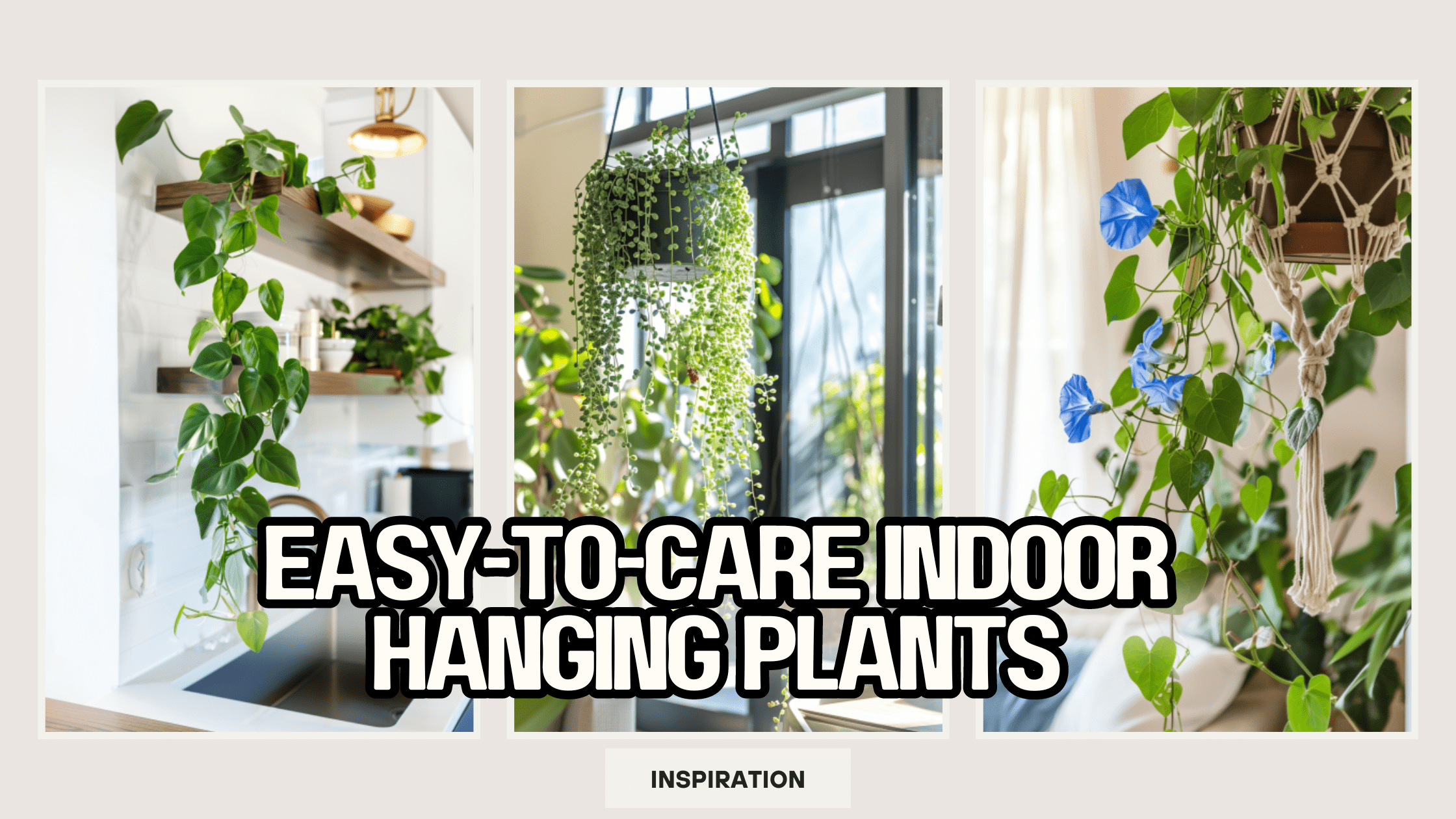A few indoor hanging plants can create a beautiful ambiance at home, and also bring a piece of nature inside your house.
Thanks to the trending phenomenon of houseplants, especially on Instagram, adding a little green is not only stylish but helps to boost your health as well.
Therefore, this is a joyful guide to some of the most popular and easy-to-care indoor hanging plants that can turn a home into a green oasis.
What to Consider Before Plant Shopping
Keep these 4 important factors in mind before you buy your green friend:
- Light: Certain plants need more light than others. Make sure you have a sense of how much natural light your space gets.
- Water: Overwatering can be just as bad as underwatering. Know the hydration needs of each species.
- Humidity: Some plants thrive in a humid environment, while others do not.
- Toxicity: If you have pets, ensure to choose plants that are safe for them.
Top Easy-Care Indoor Hanging Plants + Inspiring Ideas
1) Spider Plant
Stripey and solid green.Spider plants have arching leaves shaped like ribbons and are striped with white or are completely green. They are easy to grow and work well in just about any indoor environment.- Care Level: Loves moderate care, only needing to be watered a few times a month, and likes diffuse, bright light. Mist occasionally to simulate their native tropical rainforests.
- Pet-Friendly: 100% non-toxic.
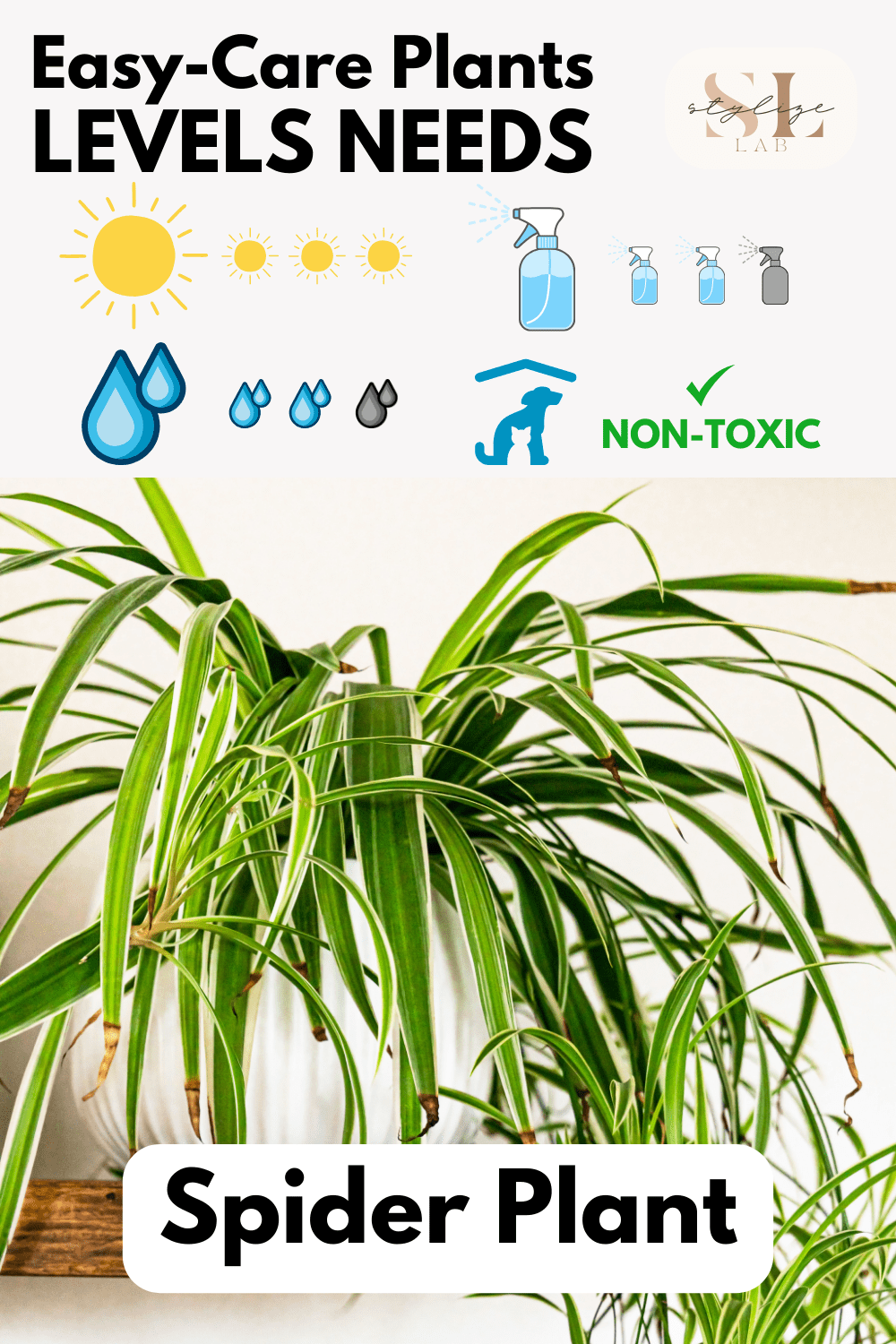
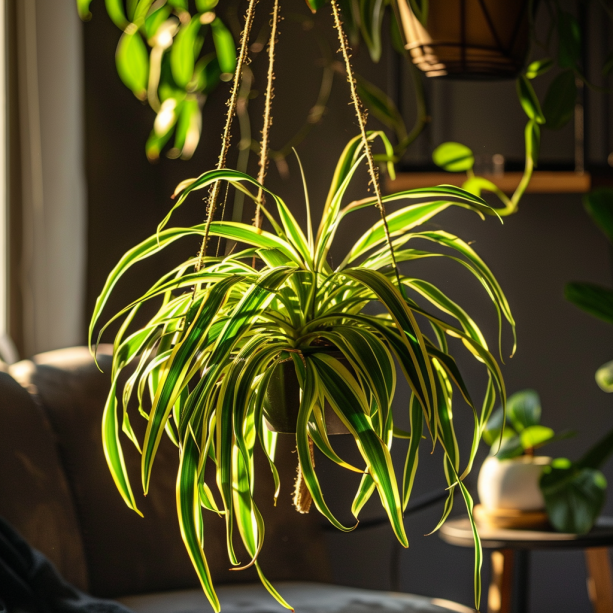
2) Boston Fern
Lush and bushy with serrated fronds.Boston ferns have that in spades, with their big, green, fluffy fronds tumbling picturesquely from their pots. They bring a certain riot of verdant arboreal tropicalism to indoor environments.- Maintenance: Hardy plants, they often only need watering every few weeks, although they enjoy mists several times a day and a cool, humid spot in indirect light.
- Pet-Friendly: Absolutely safe for pets.
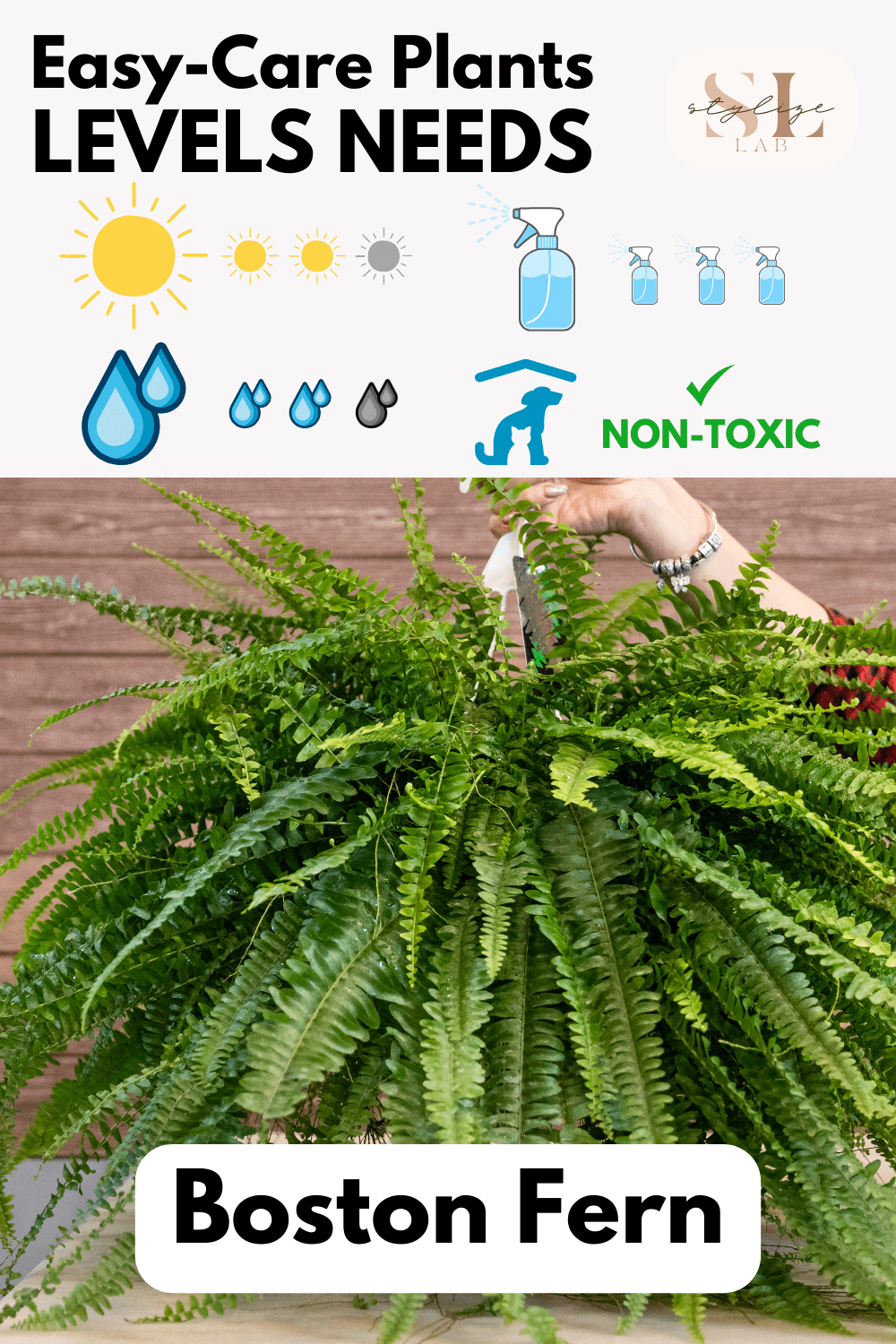
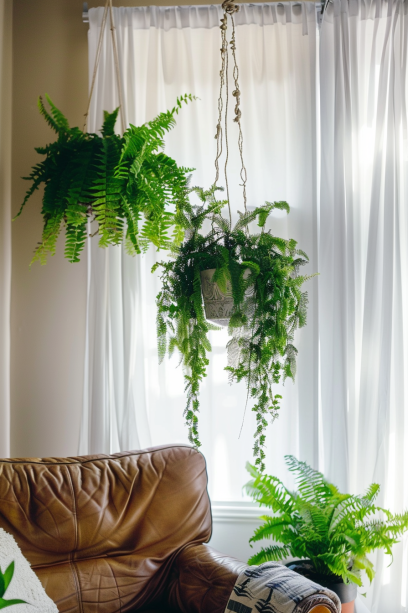
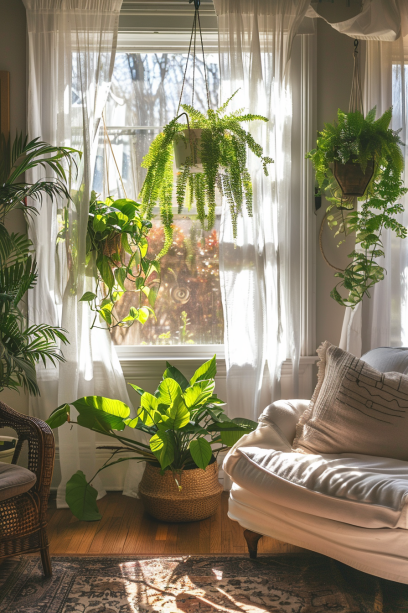
Rustic Charm with Vintage Metal Baskets
- Placement: Could be an eye-catcher in entrances or balconies.
- Suggested Plants: Ferns or trailing ivy to complement the rustic metal textures.
- Design Tip: Aging the metal baskets further can highlight a vintage aesthetic.
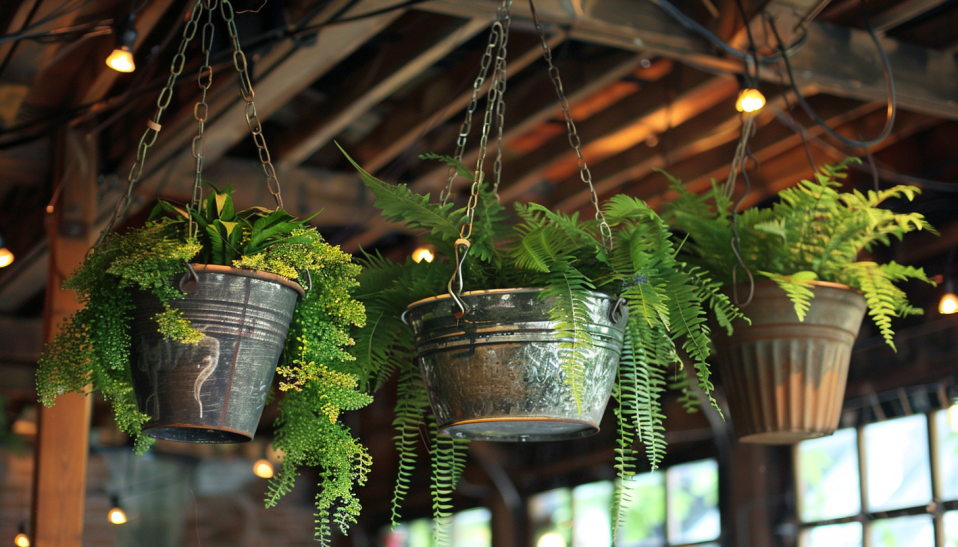
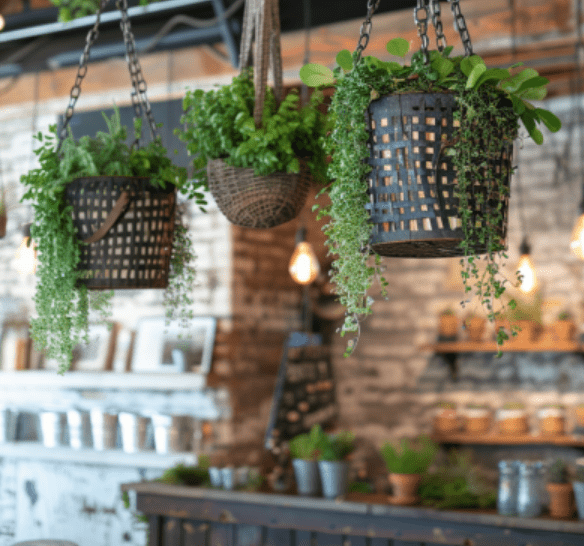
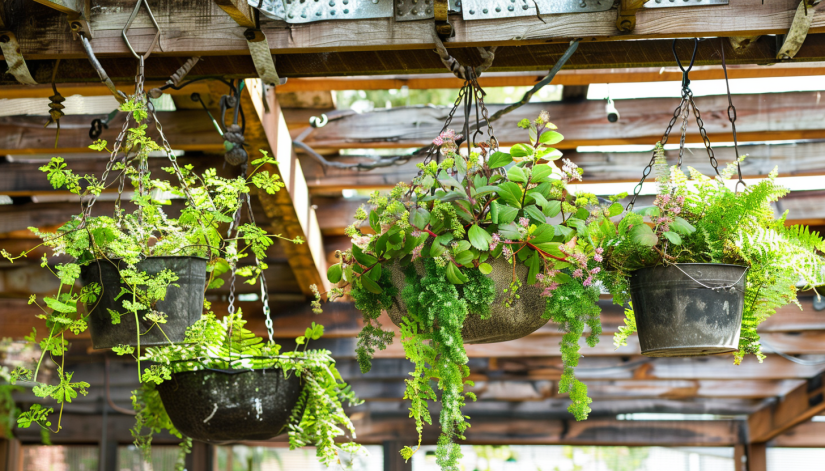
3) Heartleaf Philodendron
Philodendrons, especially Heartleaf Philodendron, are favourites because of their pretty nature and ease of care.- Looks: As the name suggests, the Heartleaf Philodendron has leaves which are heart-shaped and glossy, and a deep green colour, making it a beautiful addition to the home.
- Care: This plant comes with a reputation for being tough, so it can handle drought pretty well (a plus for those forgetful with watering). It can handle bright indirect light as well as those in lower light, making it a versatile option for indoor settings.
Pet Safety: Toxic to pets. It is advisable to hang the plants out of reach if there are pets around the house that are curious and love to chew
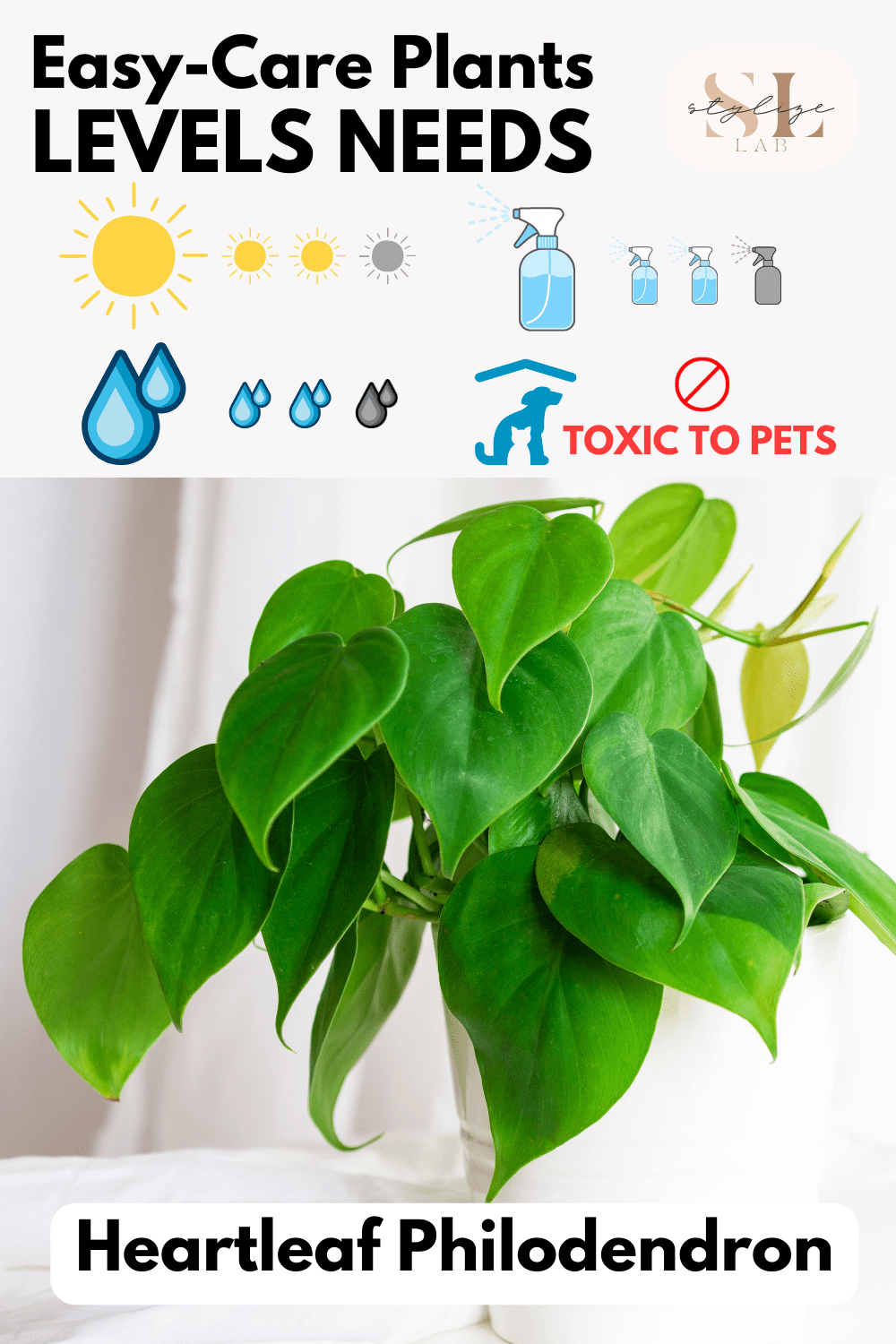
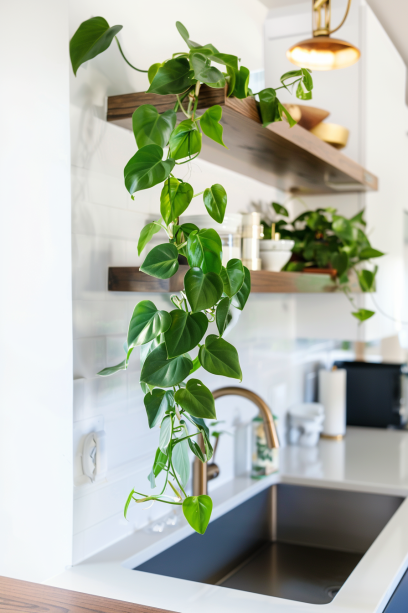
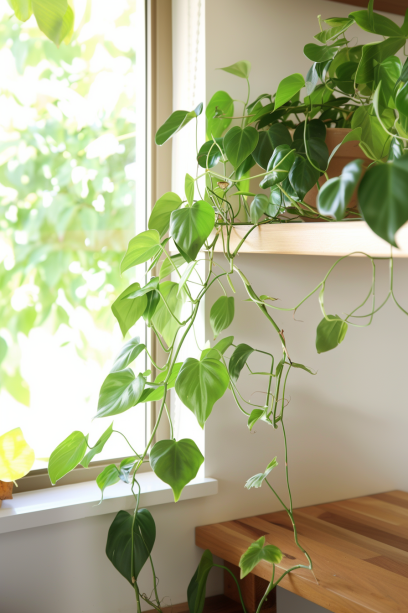
Minimalist Scandinavian Hanging Shelves
- Placement: Above work desks or in dining areas.
- Suggested Plants: Small succulents or air plants, which require minimal care.
- Design Tip: Stick to a monochrome color palette for pots to maintain the minimalist vibe.
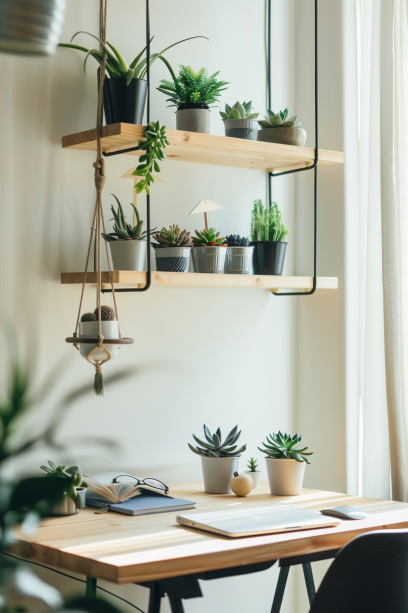
4) English Ivy
English Ivy is a vine known for its long, lush vines that creep along the ground, and make for a beautiful house plant. Fast-growing, this climbing plant can turn any indoor space into a botanical paradise.- Speed: Will grow very quickly and will cover any surface it is in contact with, including walls and floors. It is suitable for hanging baskets or high shelves.
- Light: Keep this plant in bright, indirect light. It will appreciate a few hours of morning sun or bright filtered light through a sheer curtain. It will get along with less light, but will be less vigorous and have sparse leaves.
Pet Safety: Please be careful! English Ivy is toxic to dogs and cats. If ingested it can cause vomiting, abdominal pain, hypersalivation and diarrhoea. Keep it well out of reach of pets, or choose a pet-safe houseplant if your pets like to nibble on plants.
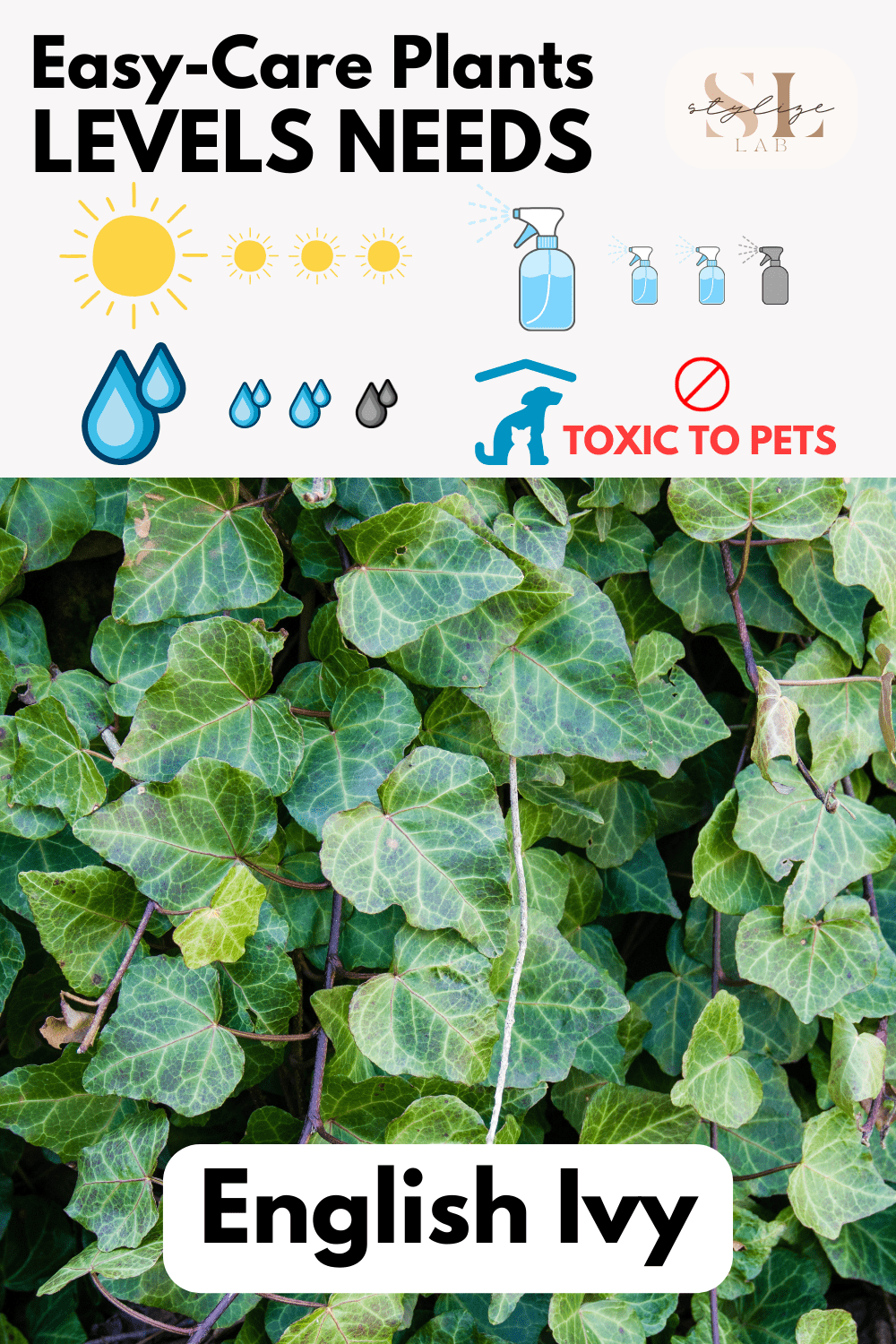
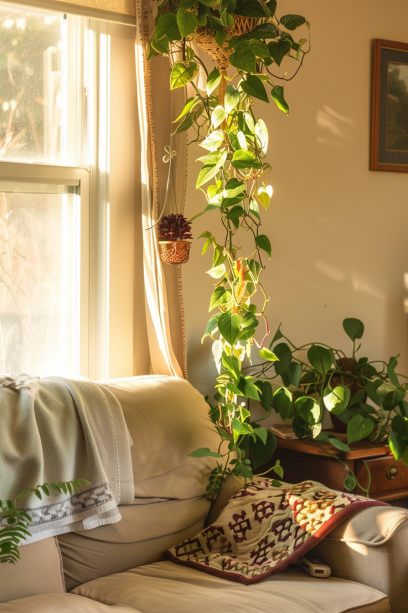 It’s also a great way to clean the air and increase your oxygen intake, but that doesn’t mean it’s a perfect plant.
It’s also a great way to clean the air and increase your oxygen intake, but that doesn’t mean it’s a perfect plant.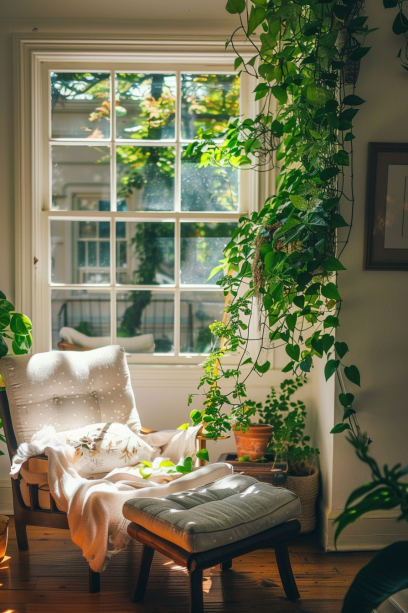
5) String of Pearls
This little succulent is a real beauty, displaying strands of plump, dark-green ‘pearls’ cascading from its pot.A sphere-shaped leaf hangs downward from the pot’s rim, in a way that’s especially fetching in a hanging basket that doesn’t conceal its tendrils.- Care: Low, no-fuss. This plant grows best in very bright, indirect light. Water just enough to keep the soil moderately moist, but be careful not to overwater – much more so than underwatering, since this plant’s fleshy leaves are able to store water. Allow the soil to completely dry out between watering sessions to avoid root rot.
- Pet Safety: Cats and dogs can have a tendency to nibble on things that are not food, and the String of Pearls is toxic if ingested.
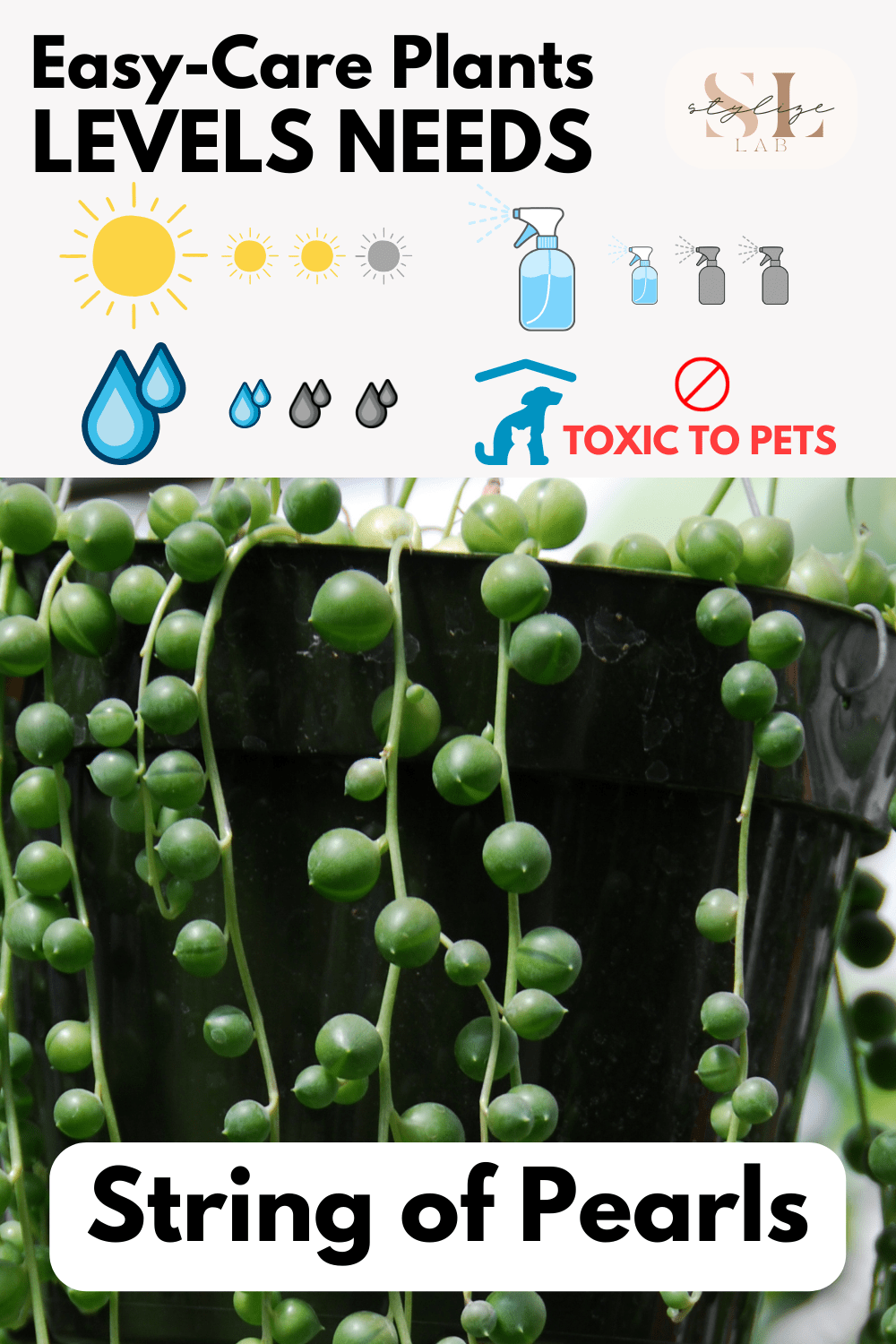
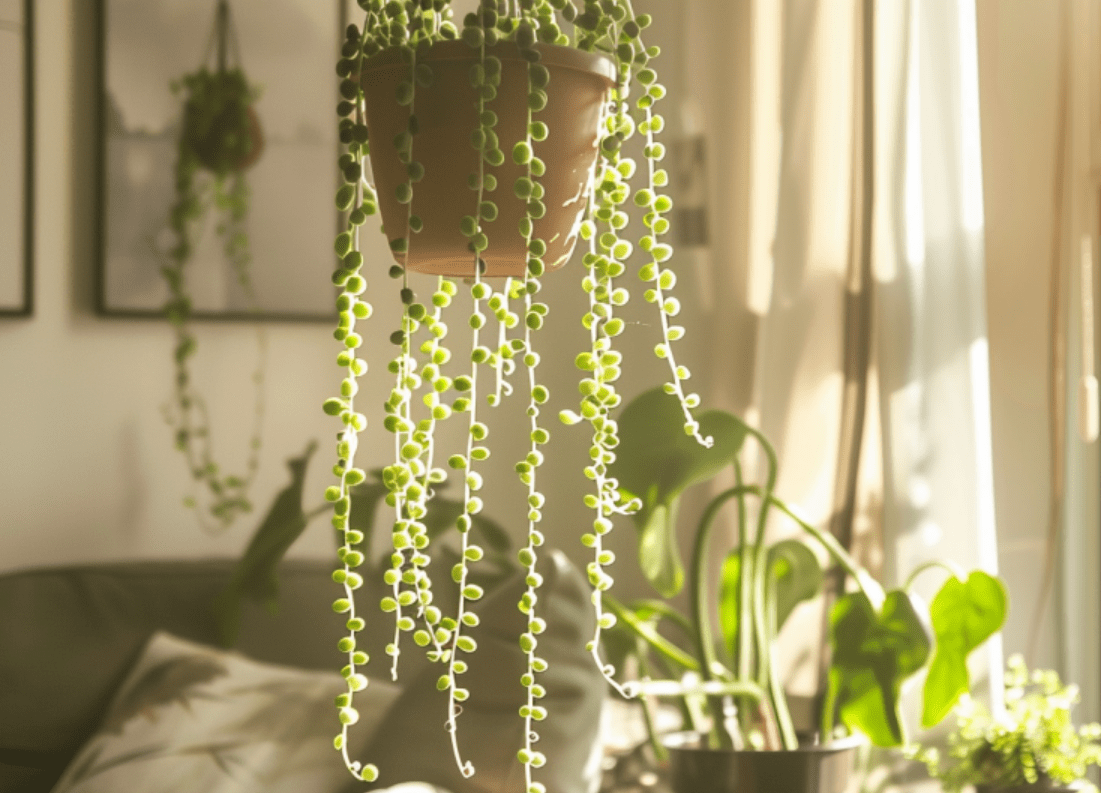
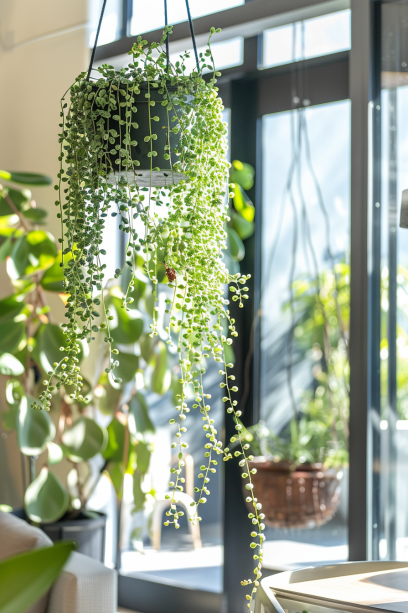
Reading Nook Accented by Hanging Greens
- Placement: Near bookshelves or by a comfy reading chair.
- Suggested Plants: Silver vine or English ivy, which flourishes in low light conditions.
- Design Tip: Incorporate soft, leafy plants to enhance the coziness of a reading corner.
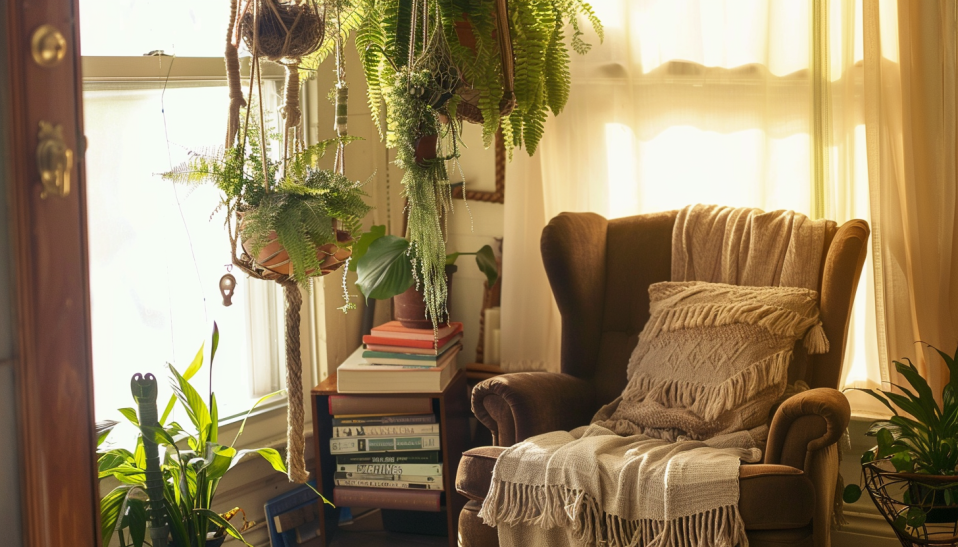
6) String of Hearts
The String of Hearts (Ceropegia woodii) is a stunning and unique hanging plant that showcases delicate, heart-shaped leaves on slender, trailing vines. Its charming appearance adds a soft, romantic touch to any interior setting.- Lighting: Prefers bright, indirect light but can tolerate some direct sunlight without harm.
- Care: This plant is known for its low-maintenance nature, requiring minimal water and moderate to bright indirect light. The thick succulent-like leaves store water, so if you forget to water it often, it’s very forgiving 🙂
- Paw-friendly: The String of Hearts is also completely non-toxic, which makes it a good option for homes with pets.
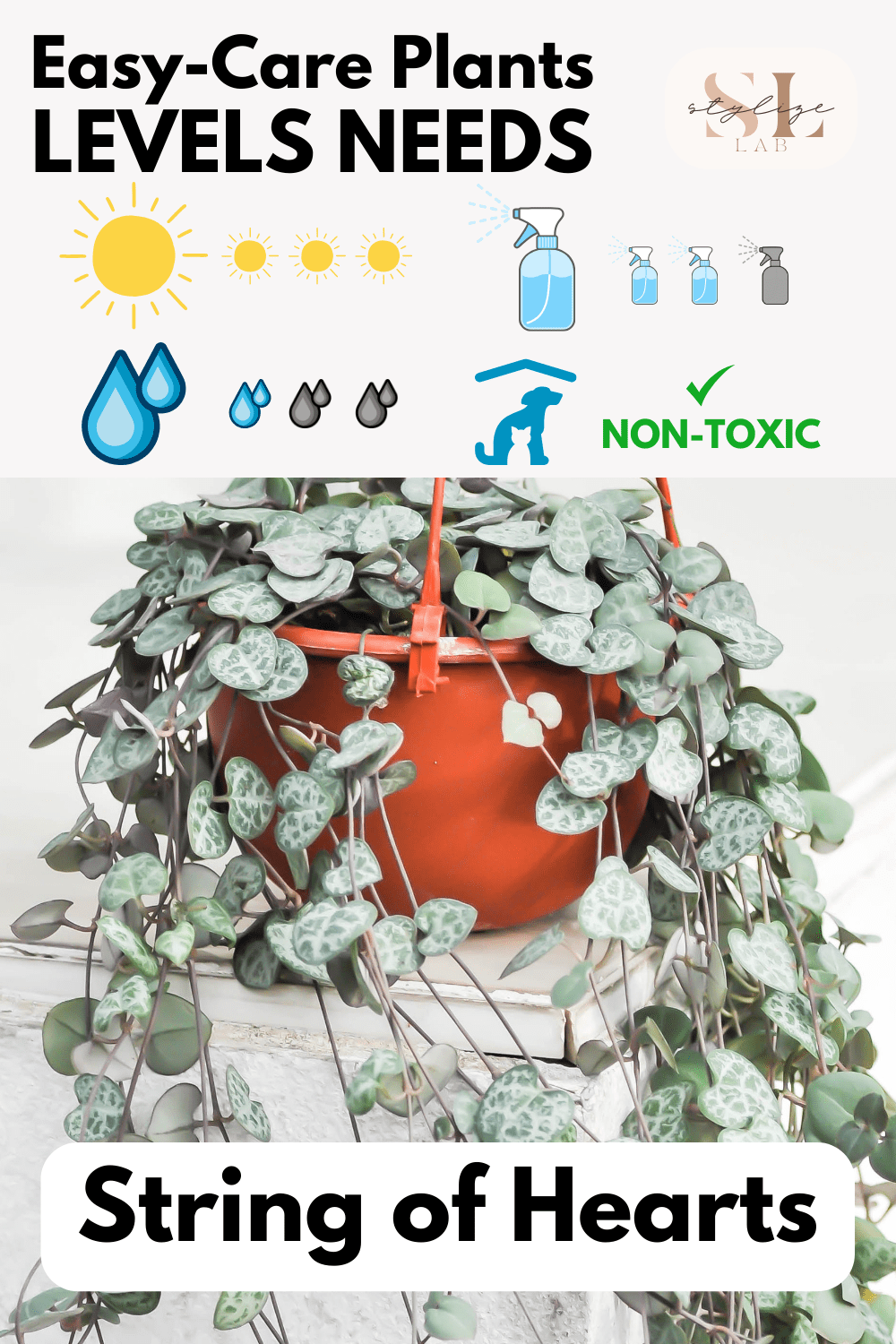
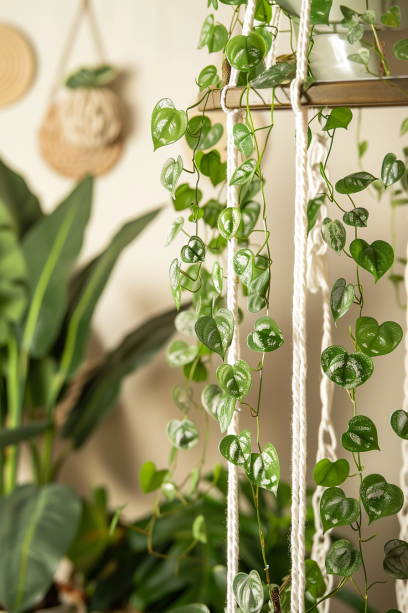
7) Mistletoe Cactus
The Mistletoe Cactus (Rhipsalis) thrives in an environment that mimics a tropical paradise:- Light: Good in low light, so it is a good option for the shadier or darker corners of your home.
- Humidity: It thrives in rooms with high humidity – bathrooms and kitchens are a good place to start.
- Special Qualities: um, it’s not just a big green bush, it’s also got delicate blooms, and eventually produce edible fruit.
- Pet Safety: Pet owners can breathe easy as it’s completely non-toxic and safe around furry friends.
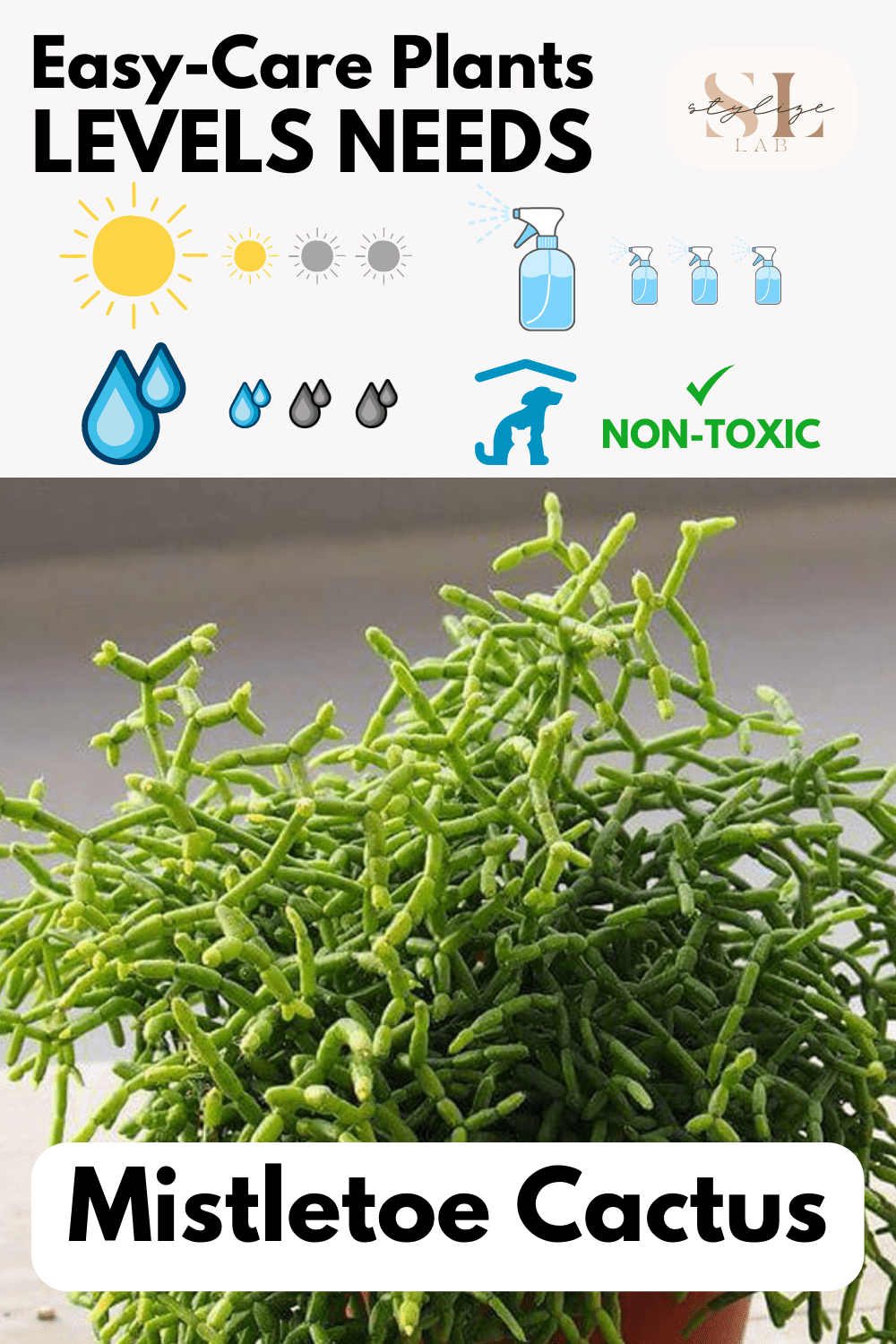
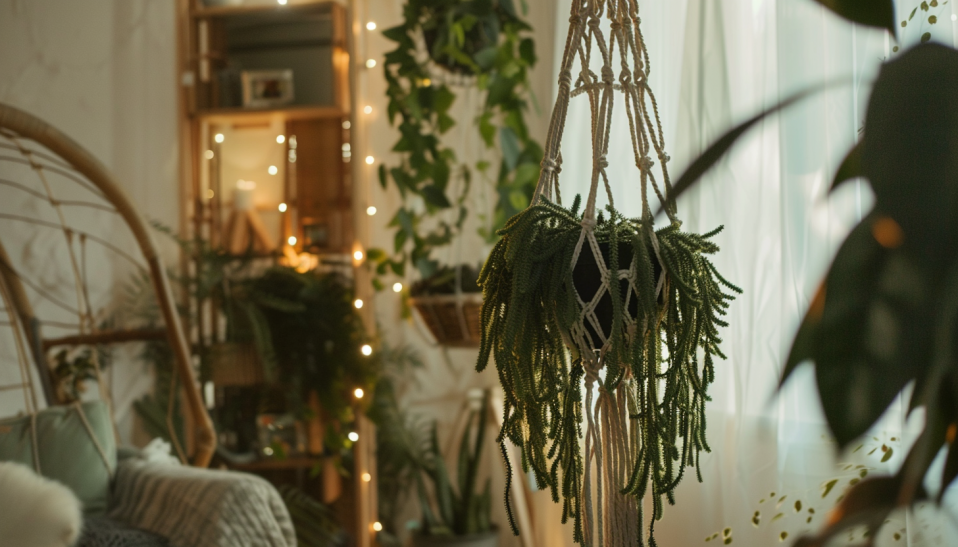
8) Devil’s Ivy
Devil’s Ivy, or Pothos, is renowned for its undemanding nature and striking look:- Care Level: Known for being very low maintenance.
- Best in low light; can tolerate higher light, and is a good candidate for lower light environments, needing only a moderate amount of sun.
- Water: Rarely needs watering, for those who struggle to find the time to look after their plants.
- Pet Safety: A word of caution— Sorry, but Devil’s Ivy is toxic to pets.
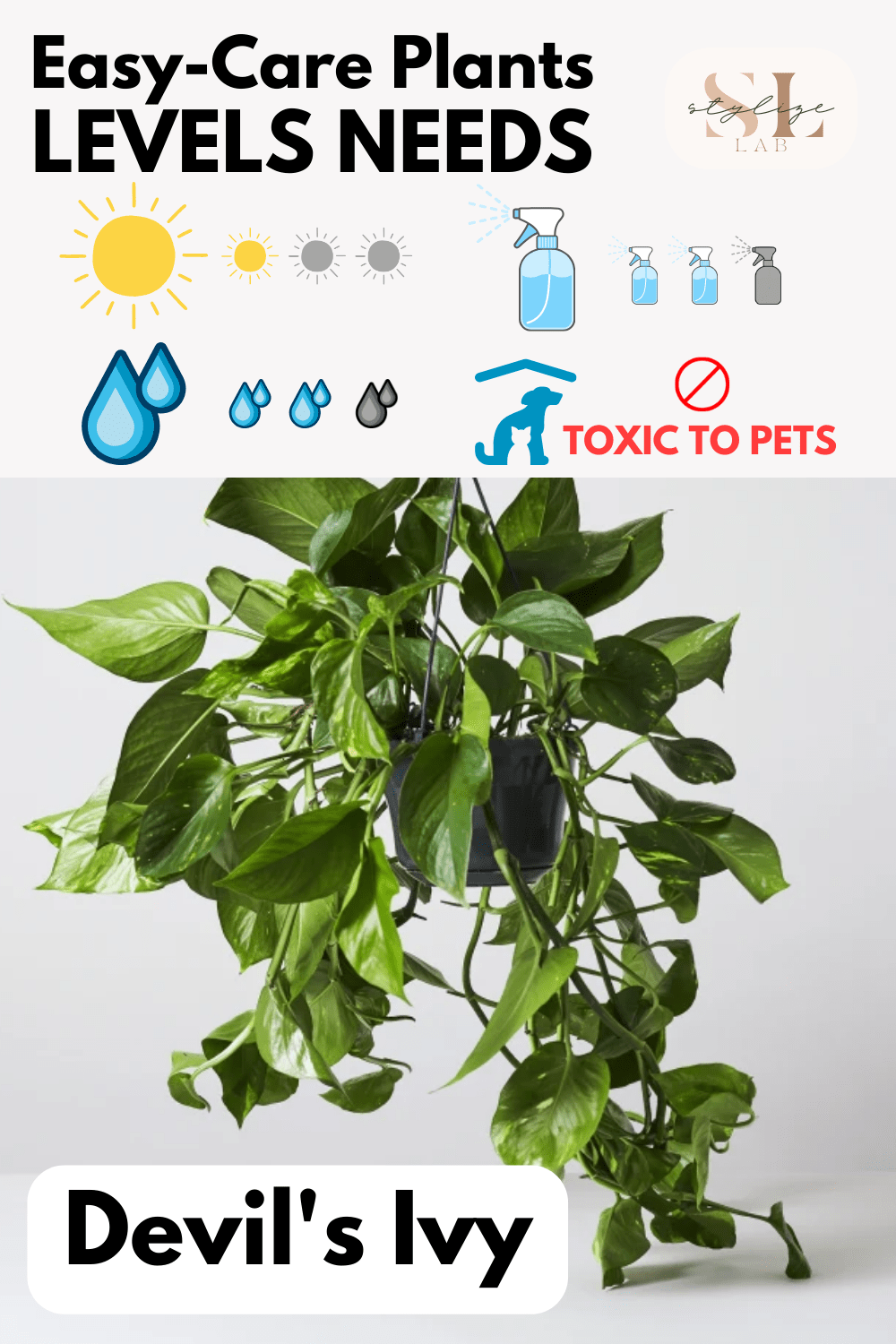
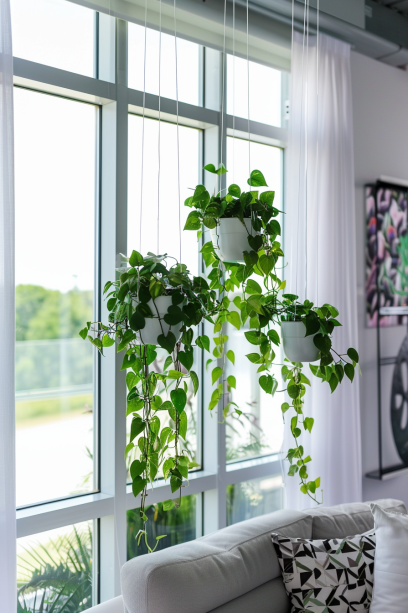
Boho Chic Macrame Plant Hangers
- Suggested Plants: Spider plants and philodendrons, as they thrive in indirect light.
- Design Tip: Choose macrame hangers with wooden beads or fringes to enhance the bohemian flair.
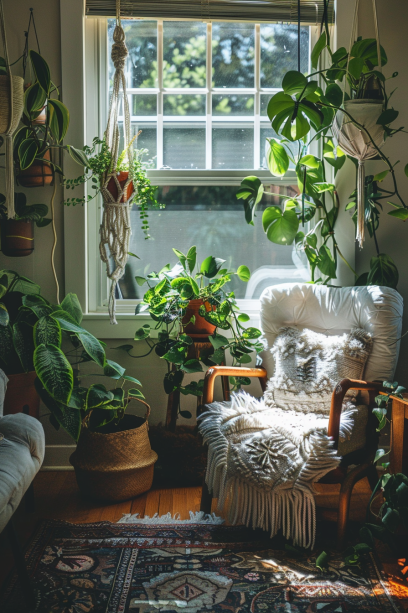 Placement: Living rooms, bedrooms, or sunny kitchen windows.
Placement: Living rooms, bedrooms, or sunny kitchen windows.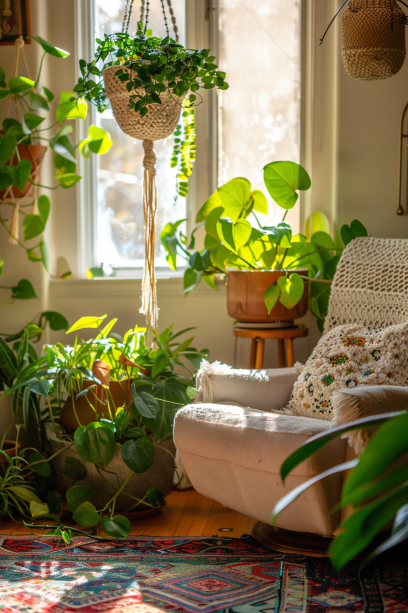
9) Morning Glory
With trumpet-shaped flowers that bloom in shades of blue, pink and purple, as well as a lush, heart-shaped foliage, Morning Glory is a showstopper in the garden.It is also one of the easiest plants to grow from seed.- Soil and Sun: Morning Glory thrives in well-draining soil and enjoys full sun.
- Watering Needs: Keep the soil moist, but be careful not to overwater.
- Support: Provide trellises or fences for support as they love to climb.
- Pet Safety: Morning Glory is toxic to pets.
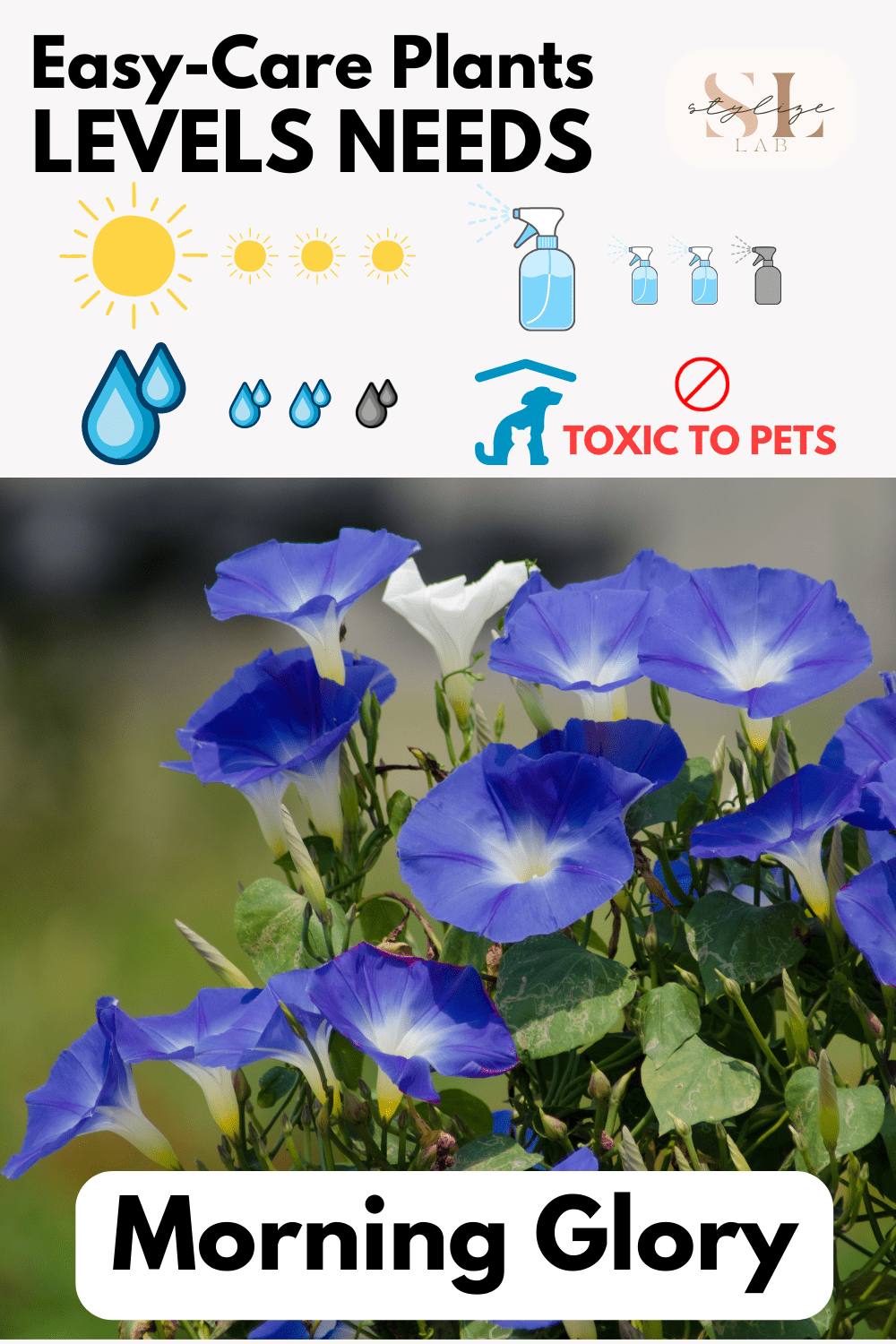
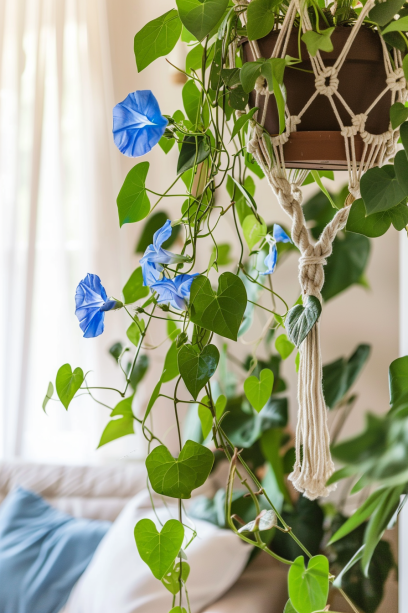 Simply broadcast seeds after the last frost, then sit back and watch the inevitable frenzy of tendrils and blossoms (usually by early summer, if you’re lucky).
Simply broadcast seeds after the last frost, then sit back and watch the inevitable frenzy of tendrils and blossoms (usually by early summer, if you’re lucky).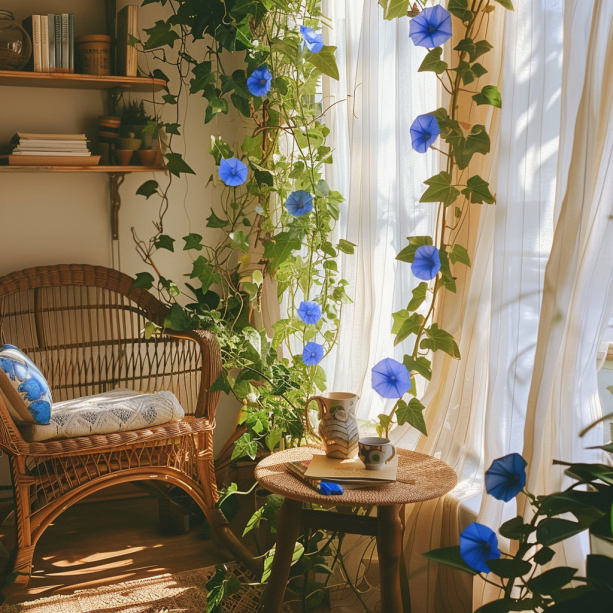
Unique Features of Hanging Plants
- Spatial Efficiency: Hanging plants are space-savers, you are able to add more green without cluttering the floor spaces.
- Visual Charm: They offer an extra vertical dimension to the decor and draw the eye upward, creating a feeling of openness and height.
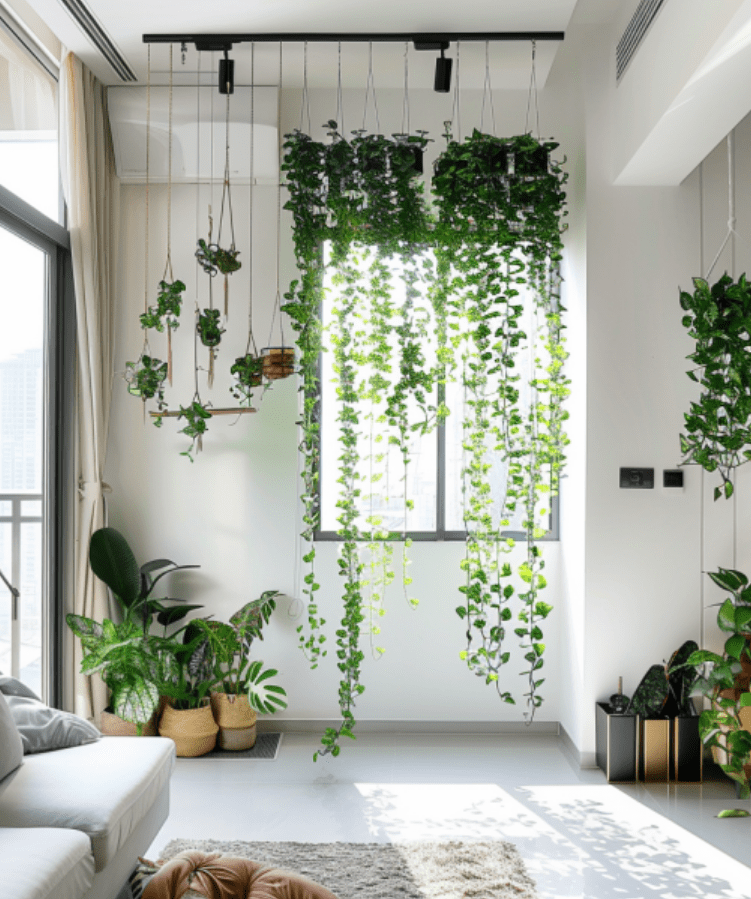
Decorating Tips Using Indoor Hanging Plants
- Use Varied Pots: Mix and match pots and planters to add an eclectic charm.
- Play with Heights: Hang plants at different levels to create a layered look.
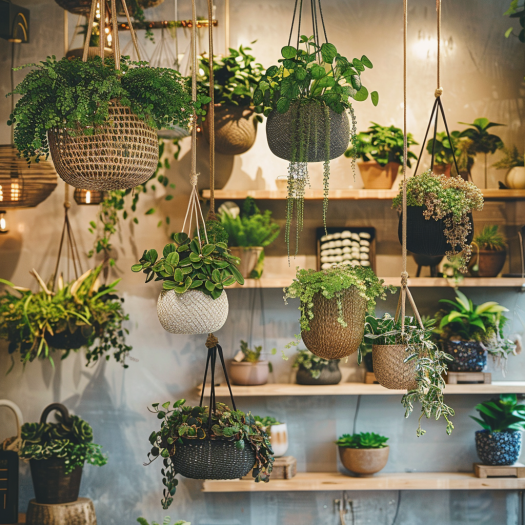
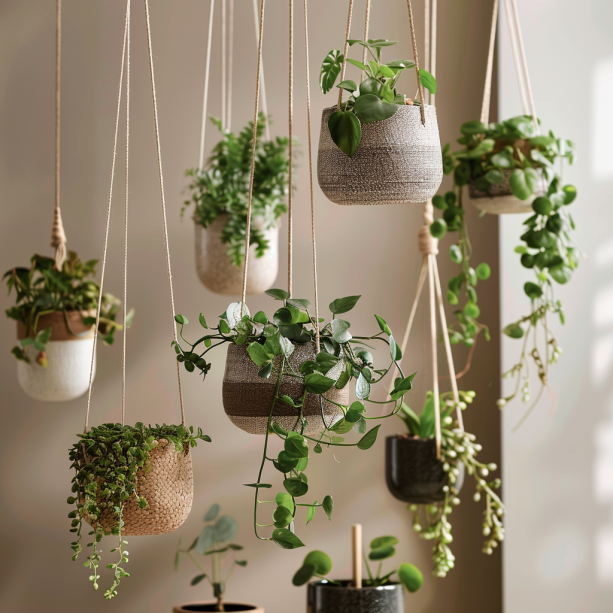 Pick Strategic Places: Put them in places where a reminder of nature is needed – above your desk, in the kitchen, or near a couch.
Pick Strategic Places: Put them in places where a reminder of nature is needed – above your desk, in the kitchen, or near a couch.Making the Most of Indoor Hanging Plants
- Build a Living Wall: Using hanging plants, you can create a living wall in your home.
- Improve Air Quality: Many hanging plants help purify the air, making your home healthier.
Design and Style: A variety of sizes and lengths will add depth to the room and to the decor.
Plants hanging from the ceiling lend an indoors space a sense of dimension – a botanical vertical – that contrasts with a square room.
Hanging plants are perfect for those who wish to bring some greenery into their living space, without sacrificing precious real estate on their floors (especially useful in small living quarters).
Here are a few more inspiring ideas to help you fill those dark corners, large living rooms and all other spots in between with hanging plants:
Modern Industrial with Geometric Holders
- Placement: Ideal for home offices or modern living rooms.
- Design Tip: Opt for bold geometric shapes to make a sharp, modern statement.
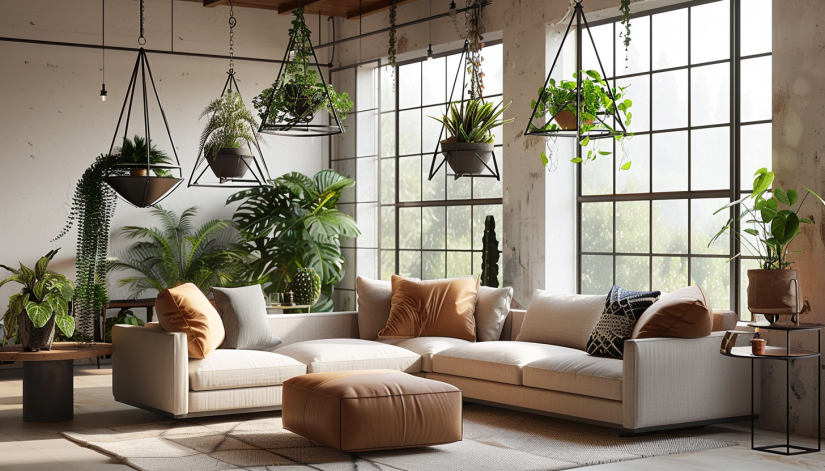 Suggested Plants: Pothos or string of pearls for a dramatic drape.
Suggested Plants: Pothos or string of pearls for a dramatic drape.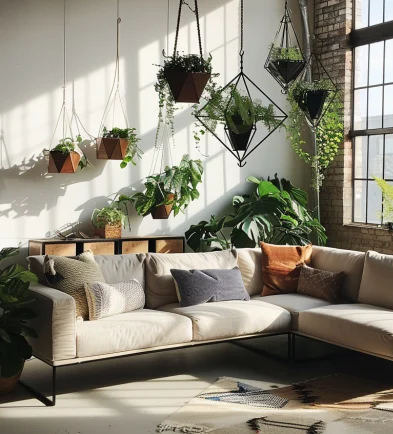
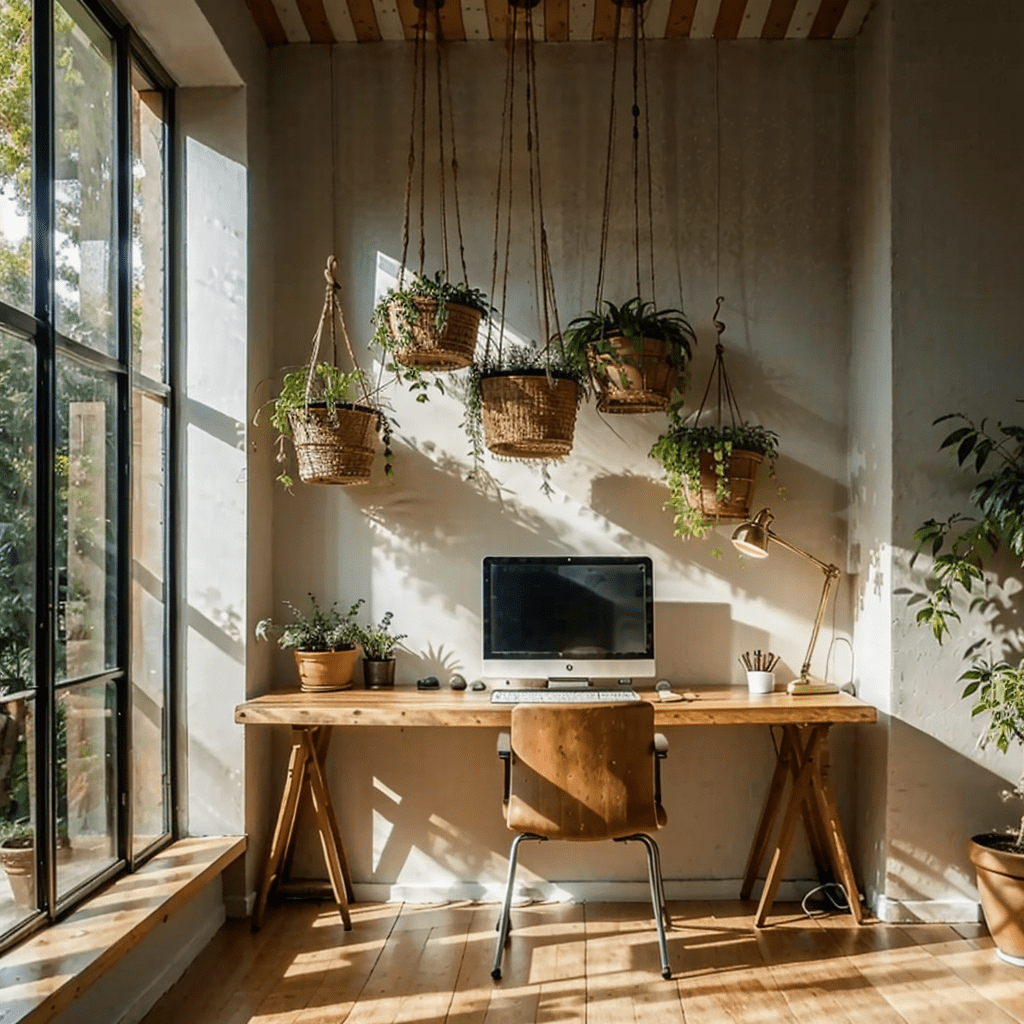
Window Wonderland Using Glass Terrariums
- Placement: Near windows to take full advantage of natural light.
- Suggested Plants: Mix of succulents, moss, and air plants for a diverse mini-ecosystem.
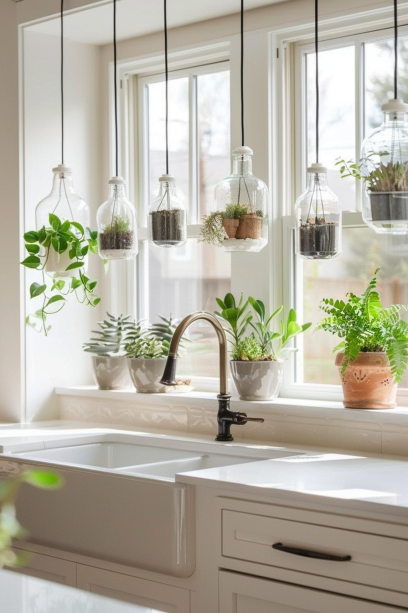 Design Tip: Use varying sizes of terrariums to create depth and intrigue.
Design Tip: Use varying sizes of terrariums to create depth and intrigue.
 See more Glass Terrariums on Amazon
The StylizeLab is powered by its readers. When you buy through links on our site, we might earn a commission.
See more Glass Terrariums on Amazon
The StylizeLab is powered by its readers. When you buy through links on our site, we might earn a commission.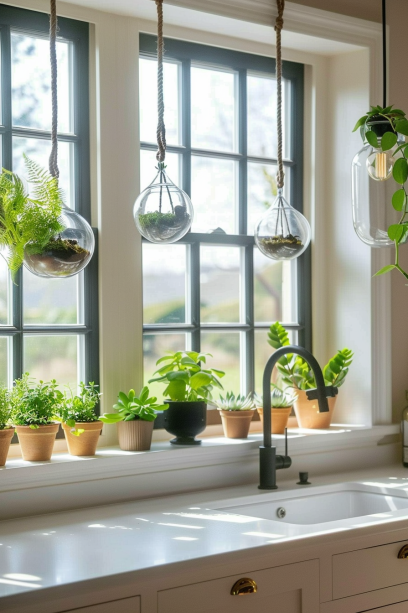
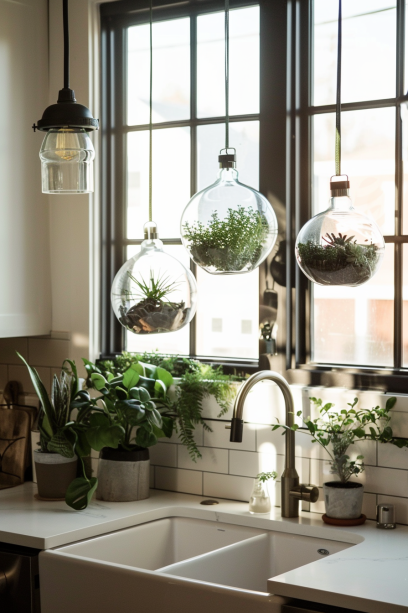
DIY Herb Garden in Hanging Baskets
- Placement: Above kitchen counters or near dining areas for fresh herbs at hand.
- Suggested Plants: Basil, mint, and thyme, handy for cooking and aromatic.
- Design Tip: Label each basket for a functional yet decorative element.
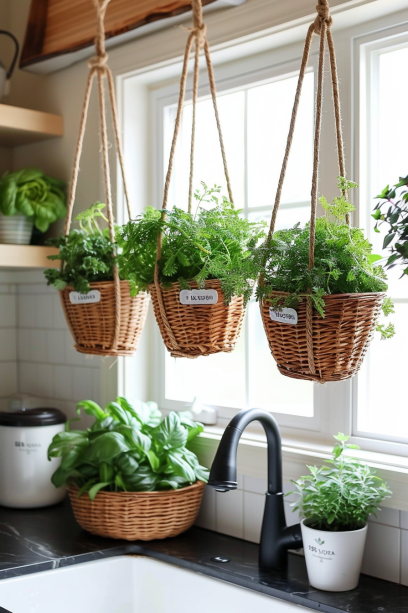
 See more Hanging Baskets on Amazon
See more Hanging Baskets on Amazon
Eclectic Living Room with Colorful Hanging Pots
- Suggested Plants: A mix of draping and upright plants such as spider plants and Boston ferns.
- Design Tip: Use a variety of vibrant, contrasting pot colors to enliven the space.
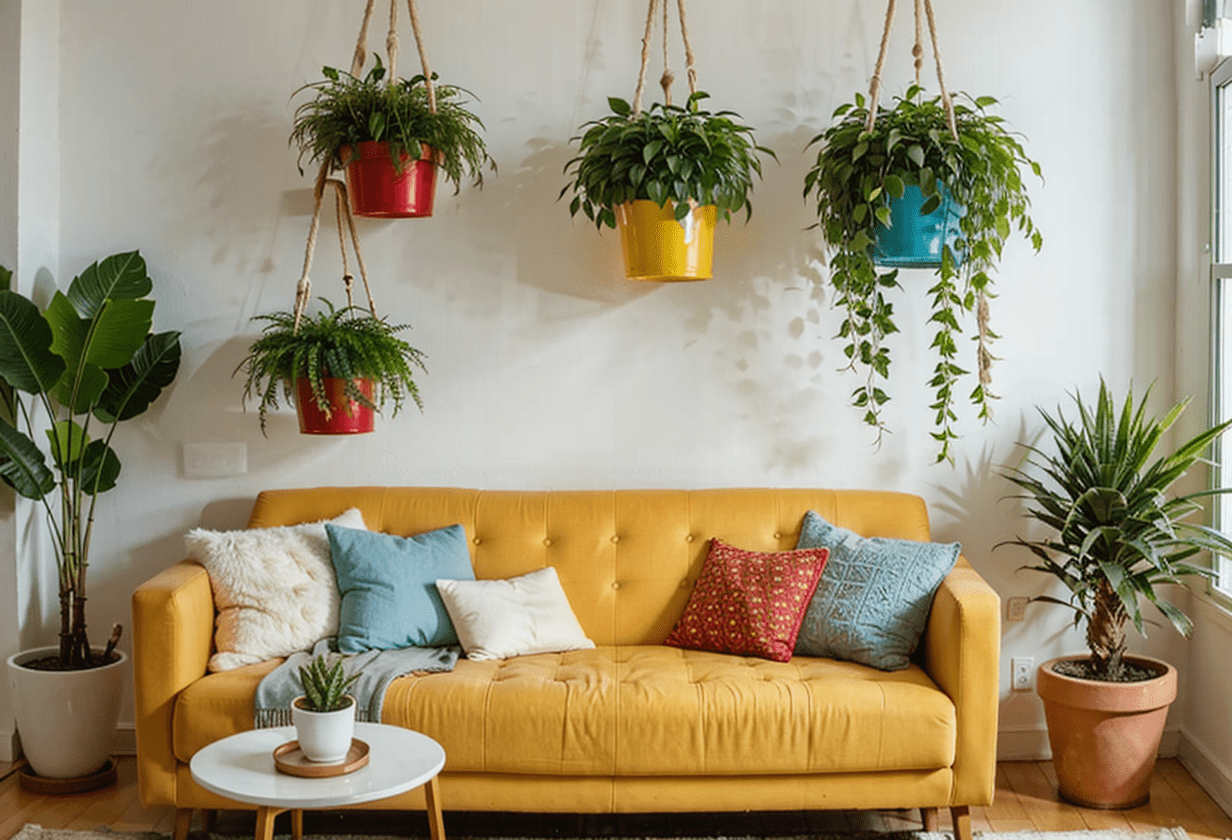
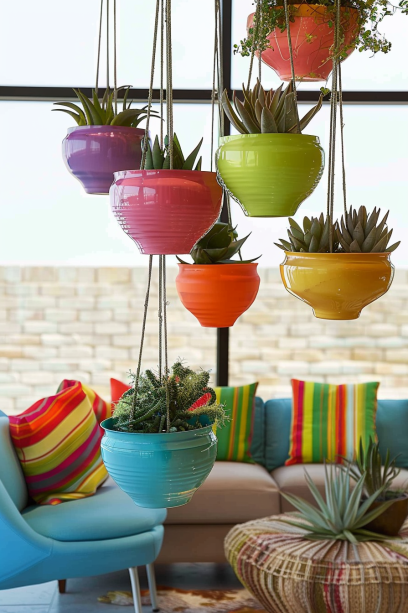 Placement: Living rooms or large hallways.
Placement: Living rooms or large hallways.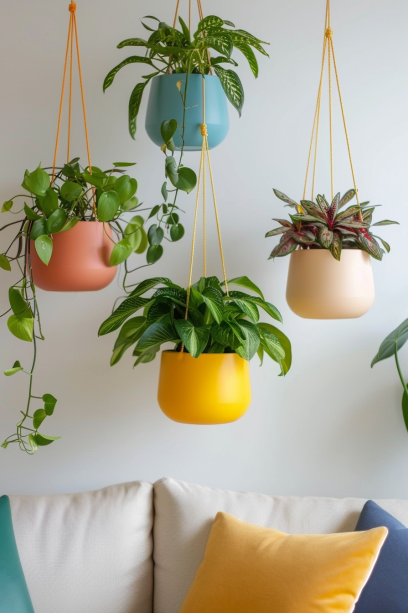
 See more Colorful Hanging Pots on Amazon
See more Colorful Hanging Pots on AmazonSpa-Like Bathroom Retreat with Hanging Ferns
- Placement: Bathrooms with sufficient humidity.
- Suggested Plants: Boston ferns or asparagus fern, thriving in high moisture environments.
- Design Tip: Use clear or lightly tinted glass pots for a fresh, clean appearance.
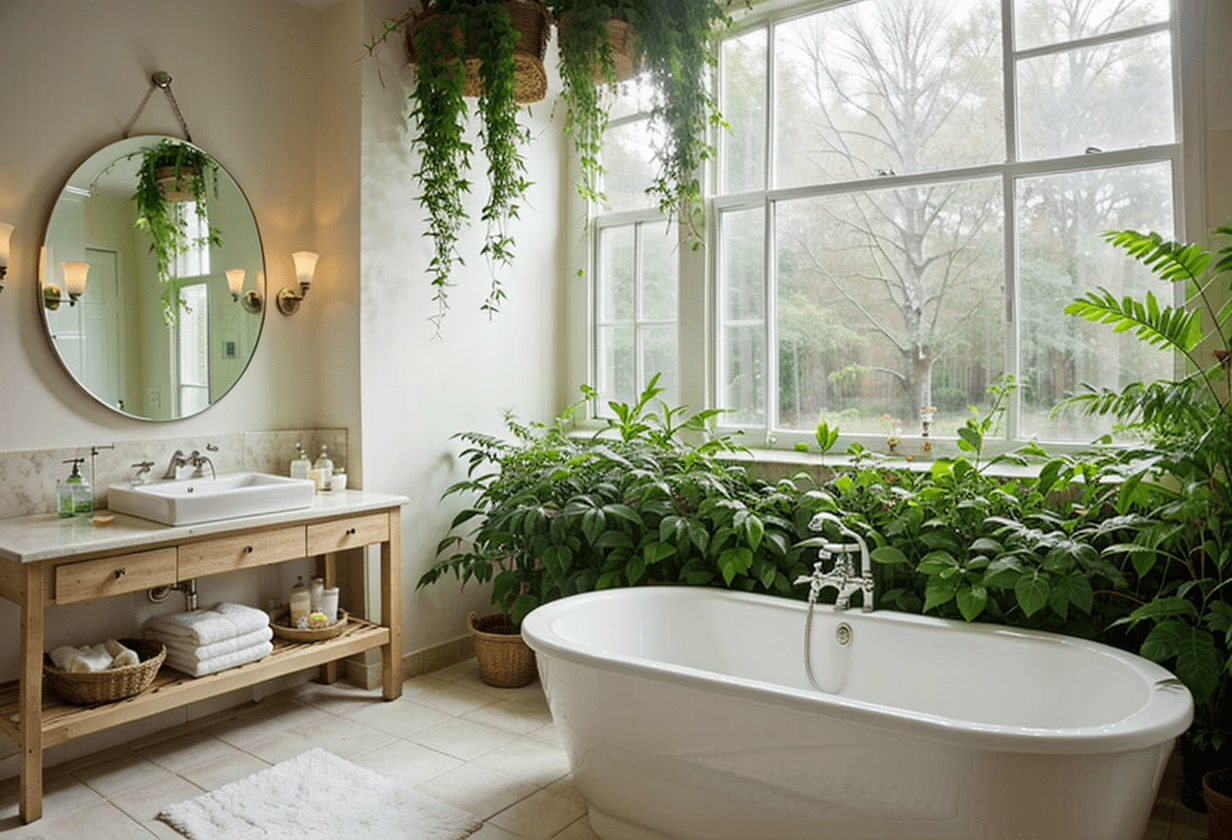
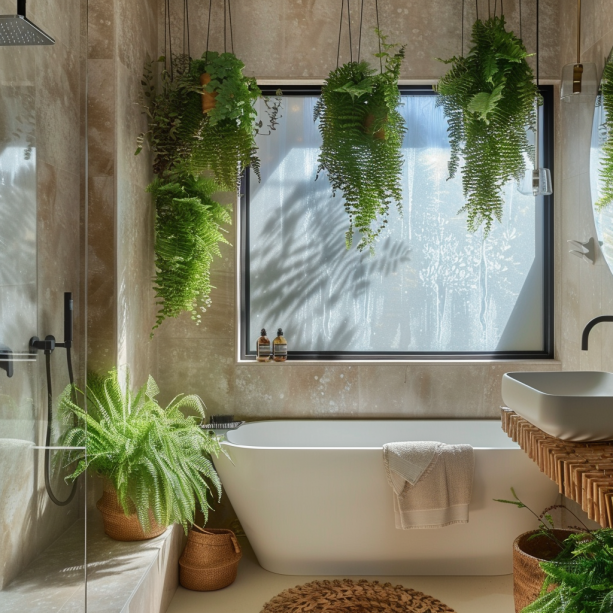
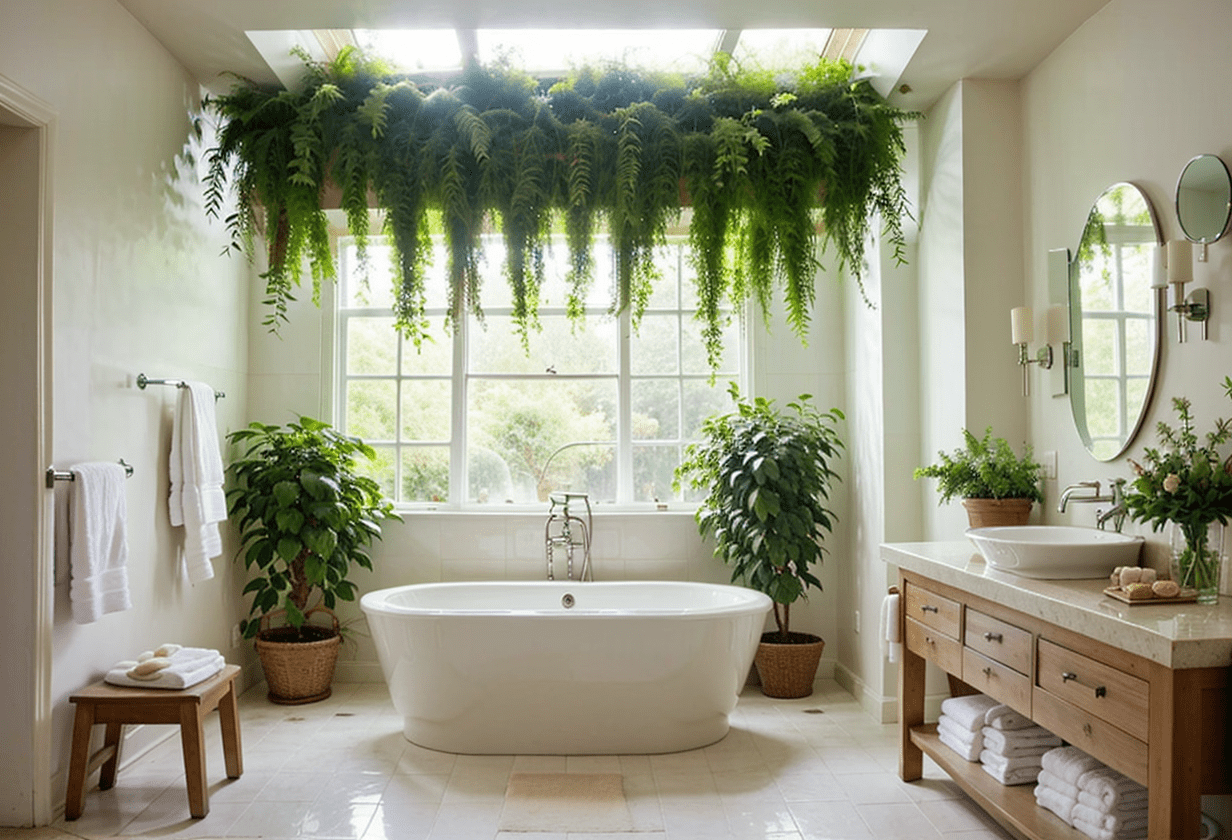
Benefits of Indoor Hanging Plants
Aesthetic: Hanging plants are beautiful and can turn unattractive rooms into more attractive ones. Adding height forces the eye upward, making rooms look bigger and more welcoming.Filters the air: Pothos and spider plants absorb many of the common indoor pollutants like formaldehyde and xylene, creating a healthier place to live.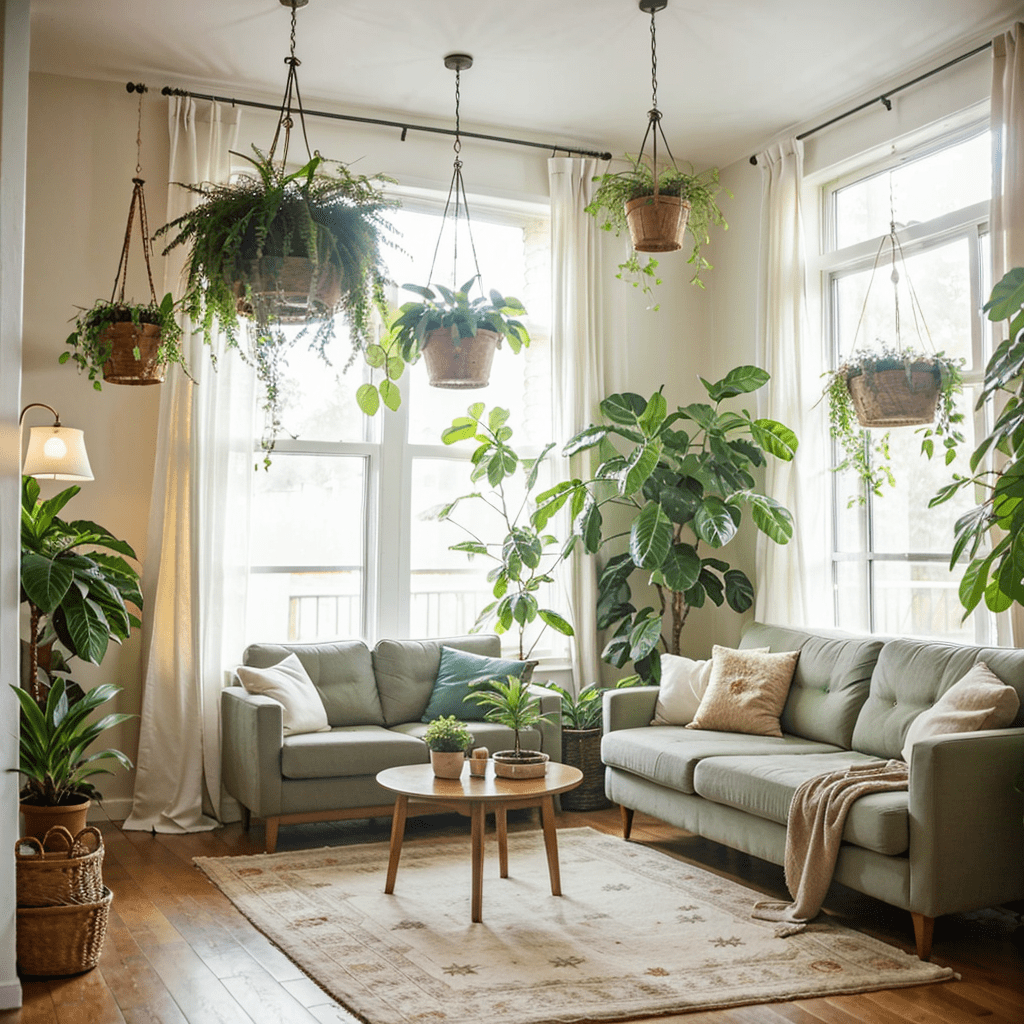
Space Savings: Because hanging plants use vertical space, they are especially useful to those with restricted or limited areas, or people who live or work in situations where floor space must be preserved.
My two favorite for beginners
I have a slight love crush on two perfect plants to start with.Devil’s Ivy or Pothos (Epipremnum aureum)
Pothos is the first plant I’d recommend to anyone new to indoor hanging plants. It’s incredibly low-maintenance, and thrives in low-light areas.If you’re busy or have a room without much natural light, this is a good bet.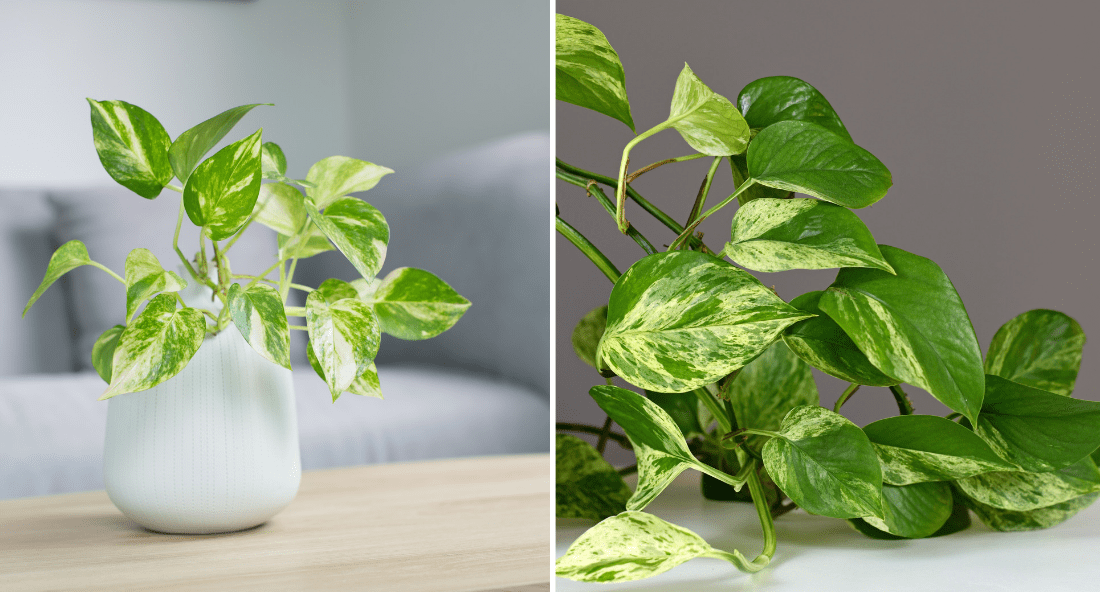 Its trailing vines have added a pop of green to the darker corners of my own living room.
Its trailing vines have added a pop of green to the darker corners of my own living room.String of Pearls (Senecio rowleyanus)
This succulent features leaves that spiral down in a bead-like style from the hanging basket or pot.
It likes bright indirect light and needs little water, making it great for forgetful waterers.
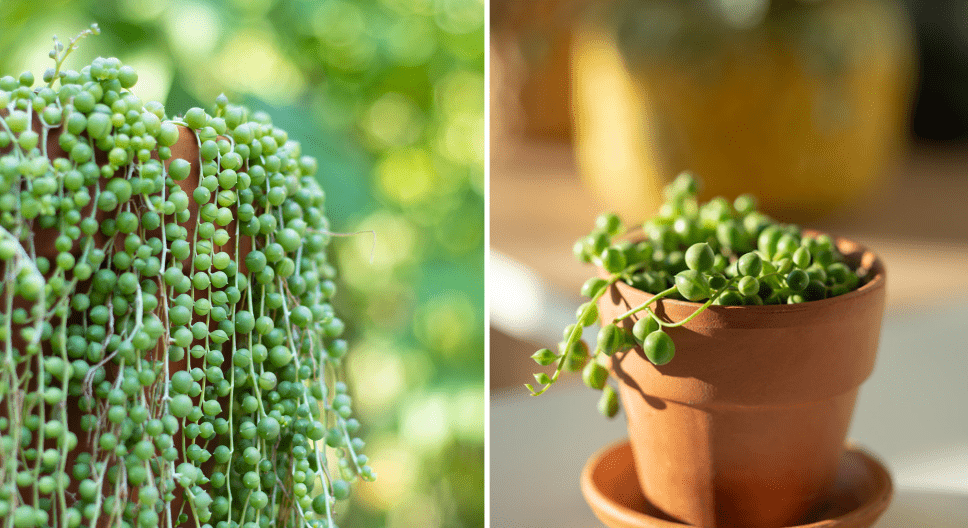 Allow the soil to dry out completely between waterings.
Allow the soil to dry out completely between waterings.Installation Tips and Care for Hanging Plants
Your indoor hanging plants will not only survive, but thrive with the right installation and ongoing care.We’re going to look at how to choose the right pots, how to install them, and how to care for them.Choosing the Right Hanging Pots
Material
The material of the pot can make all the difference in how healthy your plant stays.Terracotta and ceramic pots are popular because they look good and because they are porous, so air and water can circulate more freely, which is good for your plants.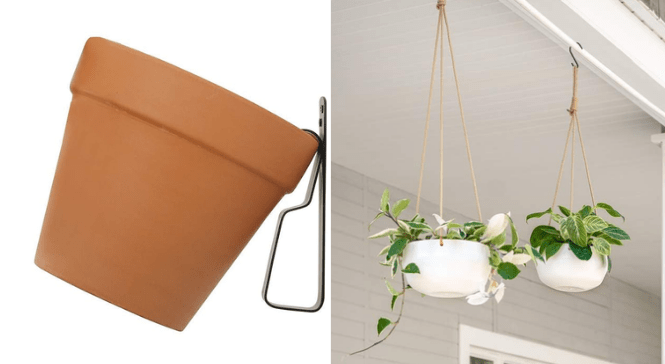 However, these materials are heavy, so if weight is a concern – for ceiling hanging, for example – you might choose plastic or fibreglass, which are lighter, and can replicate more traditional looks.See more Terracotta Pots on Amazon
See more Ceramic Pots on Amazon
However, these materials are heavy, so if weight is a concern – for ceiling hanging, for example – you might choose plastic or fibreglass, which are lighter, and can replicate more traditional looks.See more Terracotta Pots on Amazon
See more Ceramic Pots on AmazonSize
An important factor to keep in mind is the size of the pot. It should be no more than one-third as large as the root ball of the plant.🌱 The ideal size to avoid rotting.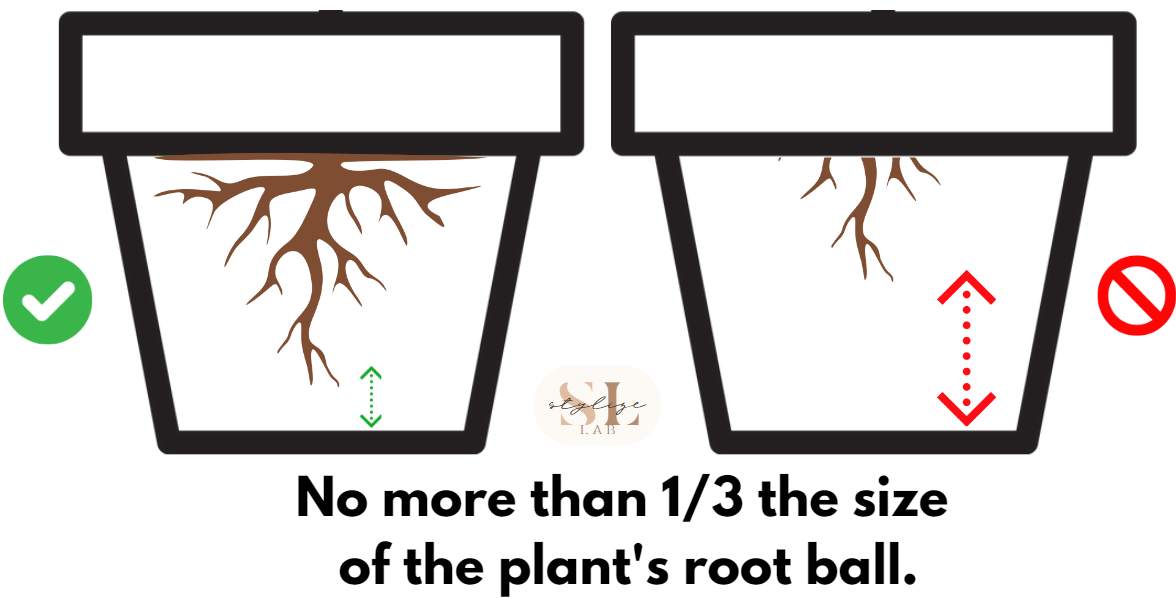 If the pot is too large, the medium will stay moister and could cause root rot.
If the pot is too large, the medium will stay moister and could cause root rot.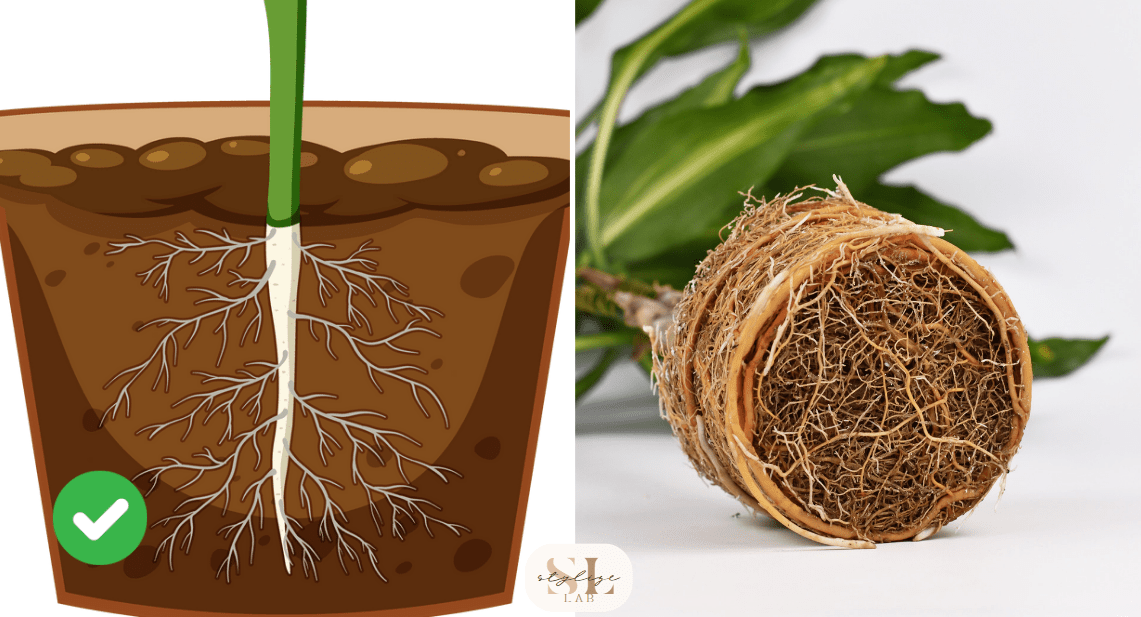
Drainage
When you plant the cactus or succulent, make sure your pot has some drainage holes.
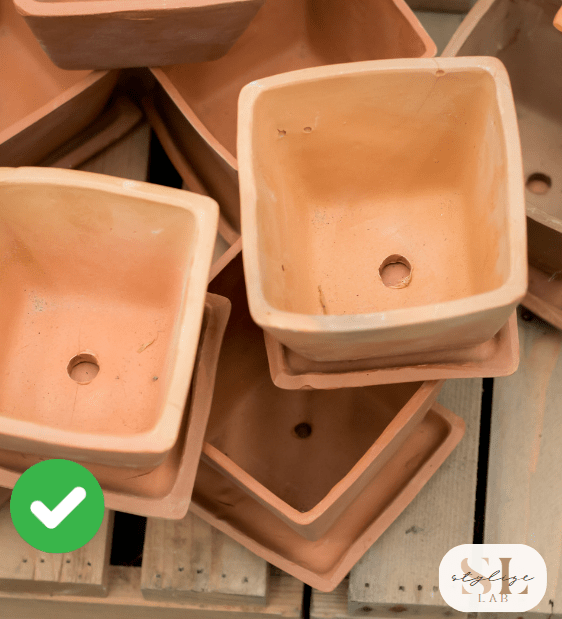
If the pot you want to use doesn’t have any, you can punch some holes in it or use it as a decorative cache pot, which is just a container holding a smaller, useful pot inside.
Installation Techniques
Ceiling Hooks: Installing a hanging plant from the ceiling requires using a solid ceiling hook.Look for a good location near a light source (if your plant variety requires one) and away from high-traffic areas to prevent accidents. Locate a beam in your ceiling with a stud find in the hook. For heavier plants, use a toggle bolt for more support.Wall-Mounted Bracket: To install a wall-mounted bracket, find a stud in the wall or use wall anchors, and secure the bracket to the wall.See more Wall Mounted Bracket on AmazonMount the bracket at a height that will allow enough light to reach the plant and won’t interfere with day-to-day activities.
For heavier plants, use a toggle bolt for more support.Wall-Mounted Bracket: To install a wall-mounted bracket, find a stud in the wall or use wall anchors, and secure the bracket to the wall.See more Wall Mounted Bracket on AmazonMount the bracket at a height that will allow enough light to reach the plant and won’t interfere with day-to-day activities.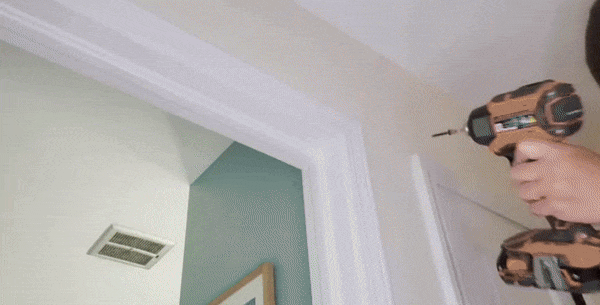 Once the bracket is mounted, place the pot in it to make sure it is level and will not tip over.
Once the bracket is mounted, place the pot in it to make sure it is level and will not tip over.Safety Tips: Make sure any hooks or hangers are designed for the weight of the plant and pot combined.
Regularly inspect fixtures for signs of wear and tear, and replace fixtures when necessary.
Care and Maintenance
Watering: Hanging plants have different requirements for watering, depending on the particular plant and the conditions of your environment.A simple tip you might have read is to water when the top inch of the soil is dry. However, don’t overdo it, as overwatering can be as harmful as underwatering.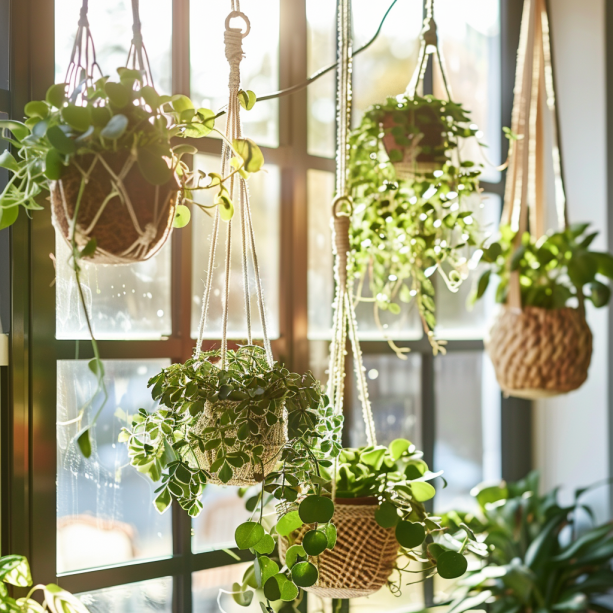 Feeding: Most epiphytes appreciate regular feeding during the growing season. Apply a balanced liquid fertiliser every 4-6 weeks, but tailor feeding to the specific plant species.Light Needs: Some plants require more light than others, so you will need to place each hanging plant where it will receive the right amount of light, from low light to full sun.You can use grow lights if natural light isn’t available.
Feeding: Most epiphytes appreciate regular feeding during the growing season. Apply a balanced liquid fertiliser every 4-6 weeks, but tailor feeding to the specific plant species.Light Needs: Some plants require more light than others, so you will need to place each hanging plant where it will receive the right amount of light, from low light to full sun.You can use grow lights if natural light isn’t available. See more Grow Lights on Amazon
See more Grow Lights on Amazon Periodic maintenance: Besides regular watering and feeding, do a periodic check for pests, prune off dead or yellowing leaves to encourage budding of new leaves, and wipe leaves to remove dust.
Periodic maintenance: Besides regular watering and feeding, do a periodic check for pests, prune off dead or yellowing leaves to encourage budding of new leaves, and wipe leaves to remove dust.Following through on these tips will help your indoor hanging plants look beautiful and be installed properly, so that you can enjoy their beauty and serenity for a long time.
Troubleshooting Common Problems with Plants
Overwatering: The most common problem, waterlogged plants are at risk of root rot. If the soil is soggy and the cactus feels spongy, with droopy, yellowing leaves and a mushy stem base, that’s the problem.Let the soil dry out quickly, improve drainage in the pot and reduce your watering schedule.Underwatering: Symptoms are dry, crispy leaves and stunted growth. Revive under-watered plants by taking them in incrementally more water until their root zone is coated with water.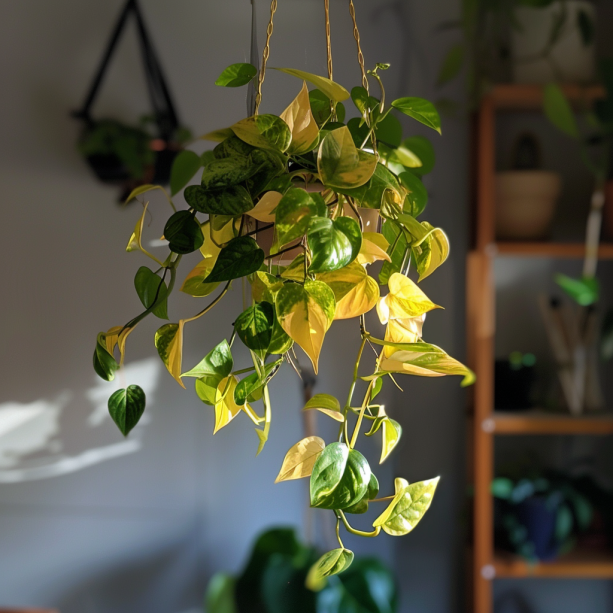 No Nutrients: Plants look stunted, pale, yellow or slow-growing. Use a balanced, water-soluble fertiliser, every 4 to 6 weeks.
No Nutrients: Plants look stunted, pale, yellow or slow-growing. Use a balanced, water-soluble fertiliser, every 4 to 6 weeks.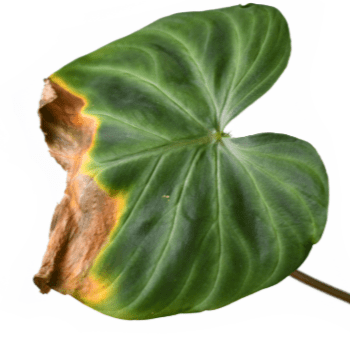 Poor Health: If you see signs of drooping leaves, spotting, or insects, that’s a sign of poor health.Some simple solutions:
Poor Health: If you see signs of drooping leaves, spotting, or insects, that’s a sign of poor health.Some simple solutions:- Underwatering: Give them more water.
- Pest: Use pesticides or spray them with water to remove.
- Fungal: Use neem oil.
Emergency Care: For quick relief, change your watering habits, prune back damaged or diseased areas, and make sure your plant is getting adequate light.
If the plant still doesn’t thrive, repot it with fresh, well-draining soil and hopefully it will be rejuvenated.
What are some fast growing indoor plants?
Most people looking to green their interiors fast would do well to start with Pothos / Devil’s Ivy (Epipremnum aureum) and Spider Plants (Chlorophytum comosum), both for their quick growth and for their undemanding needs.Pothos (Epipremnum aureum)
- Air Purifying: Removes common indoor pollutants.
- Shade Tolerant: Grows in low-light conditions.
- Easy Propagation: New plants can easily be grown from cuttings.
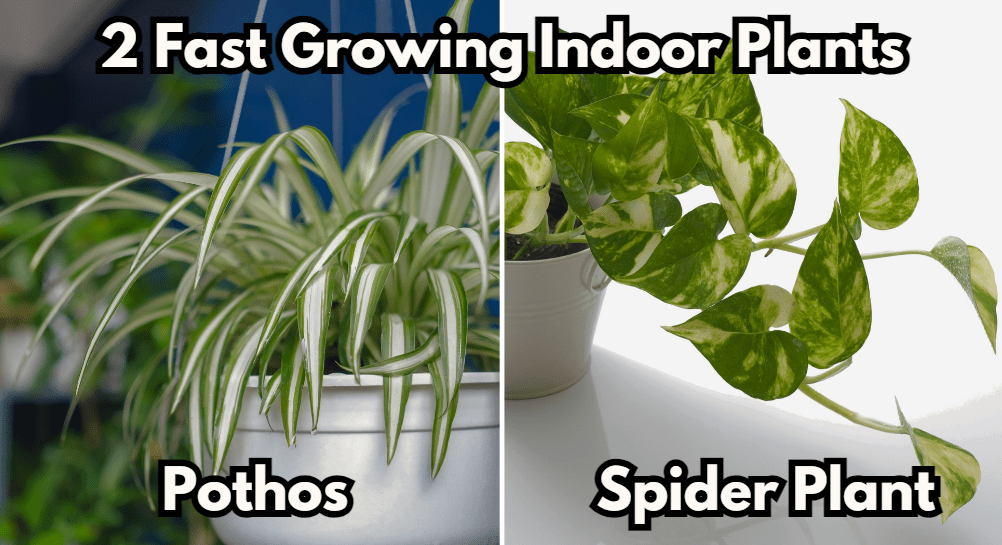
Spider Plant (Chlorophytum comosum)
- Produces Offshoots: Easily multiplies by growing “pups.”
- Air Cleaning: Recognized by NASA for removing toxins like carbon monoxide.
- Resilient: Thrives under various conditions, almost indestructible.
Conclusion
There are many benefits to growing hanging plants indoors, including adding a touch of colour and life to every corner of your home, purifying the air as they grow, and even helping you to reduce stress levels.
With the right pot, hanging basket or planter, and a little know-how, you can develop an interior landscape that’s perfectly suited to your taste.
From calming foliage for the bedroom to striking planters filling your living room, there’s an option to suit every interior.

